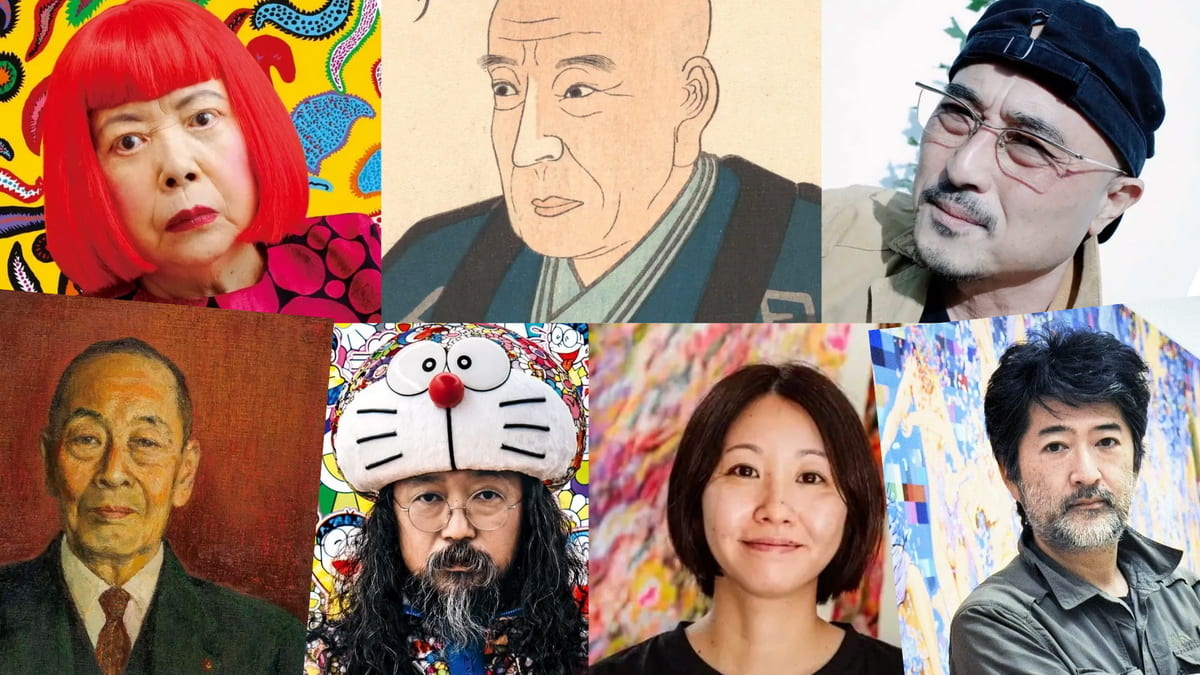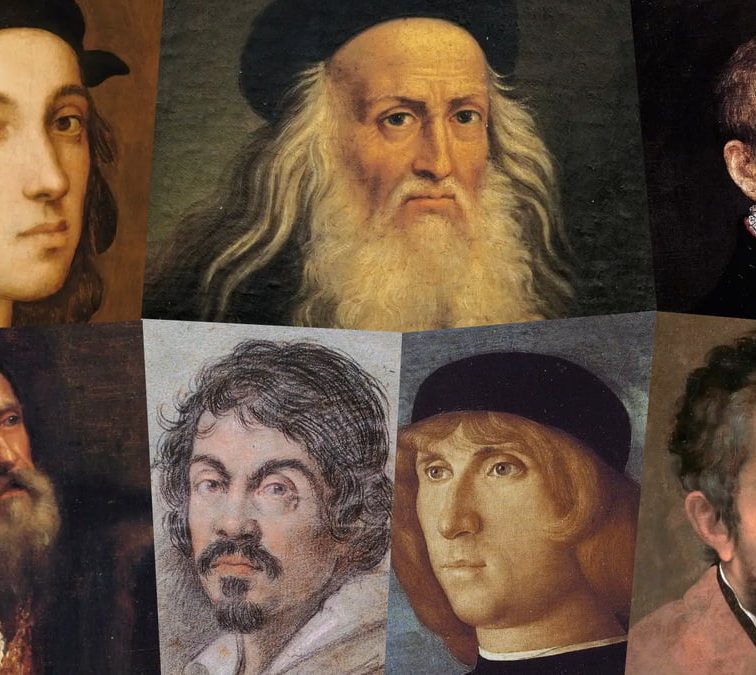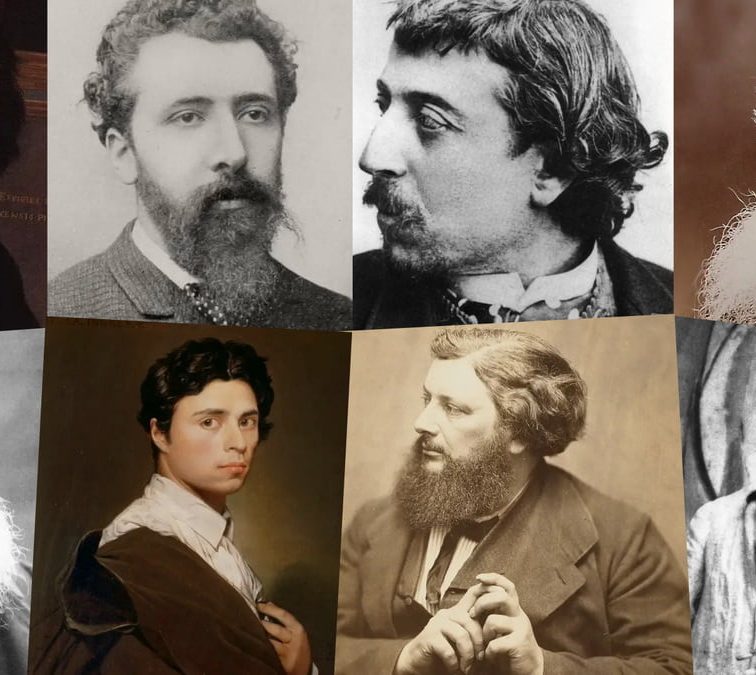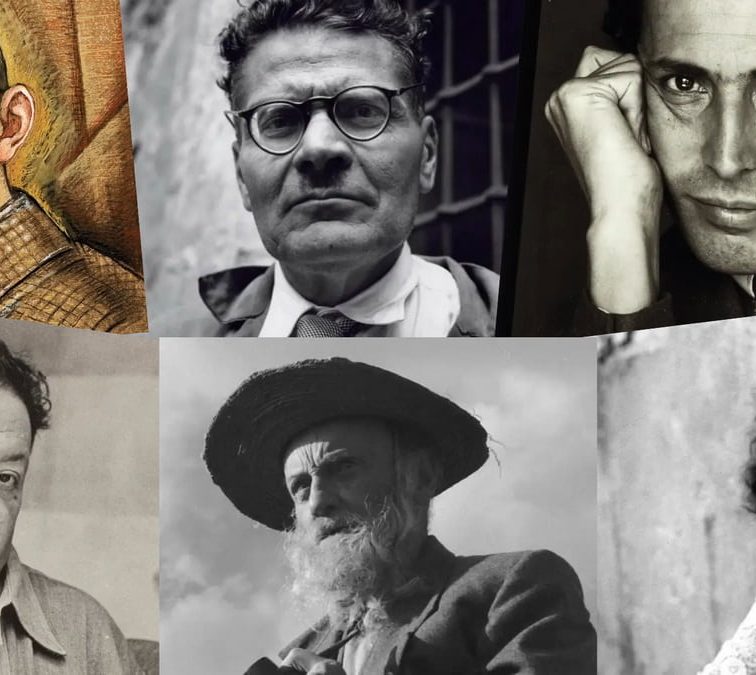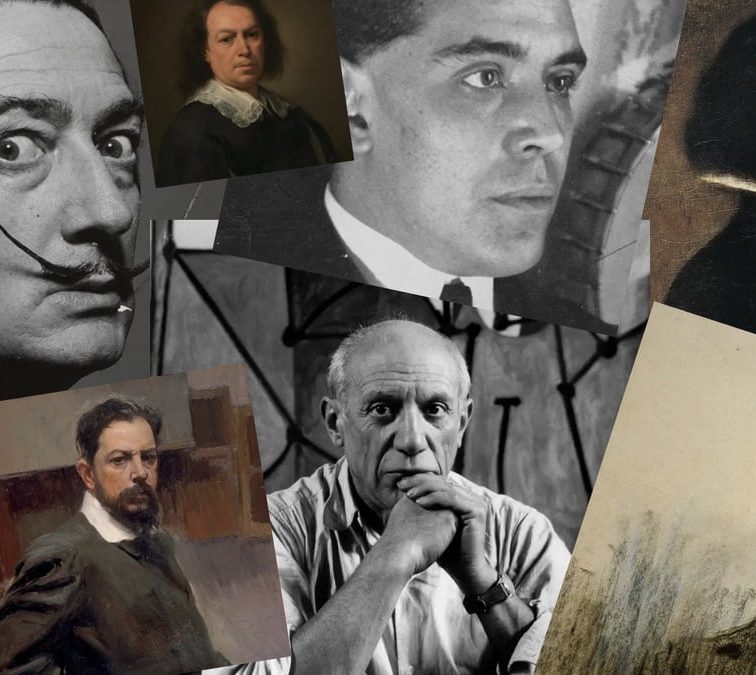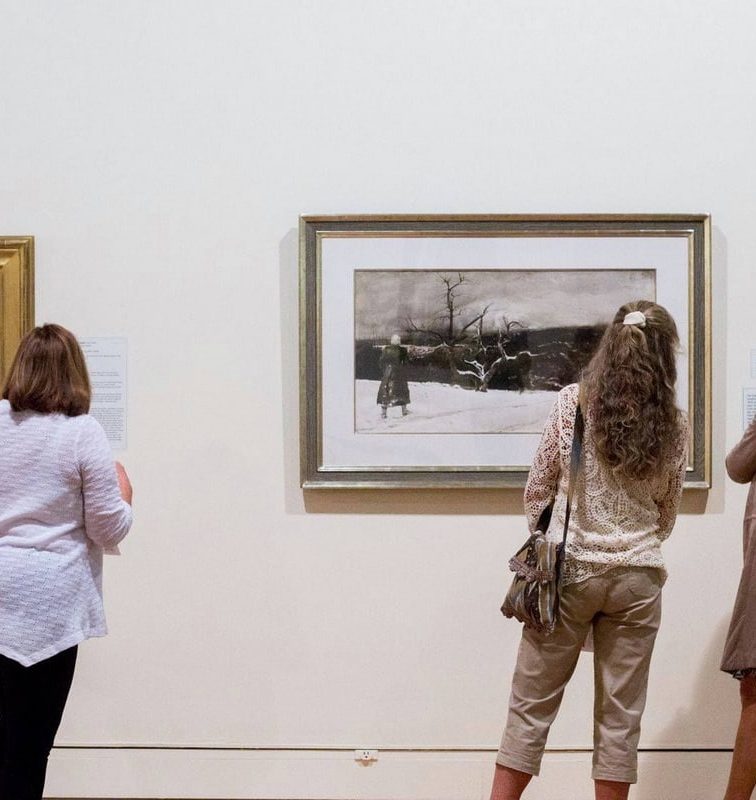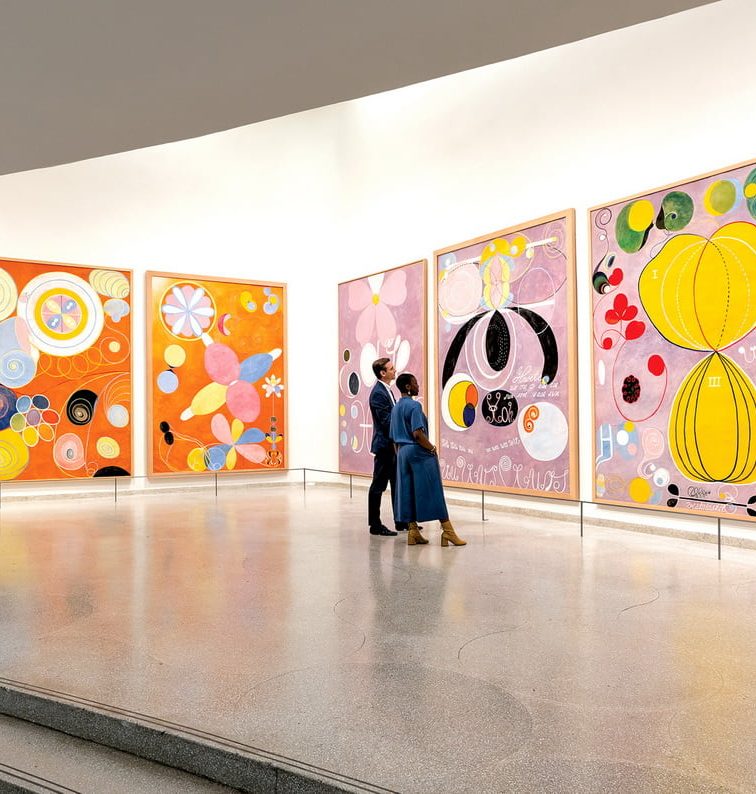Japan, an island nation where ancient traditions and cutting-edge innovation blend seamlessly, has given birth to a unique and vibrant art scene. Imagine a world where the whimsical polka dots of Yayoi Kusama coexist with the iconic wave of Katsushika Hokusai. Picture Takashi Murakami’s kaleidoscopic universe colliding with Hiroshige’s serene landscapes.
Each artist on this list has revolutionized not just Japanese art, but the global art narrative, pushing boundaries and challenging perceptions. From the dream-like sculptures of Mariko Mori to the thought-provoking works of Makoto Aida, we explore the vibrant tapestry woven by the most famous Japanese artists.
1. Katsushika Hokusai: Beyond The Great Wave
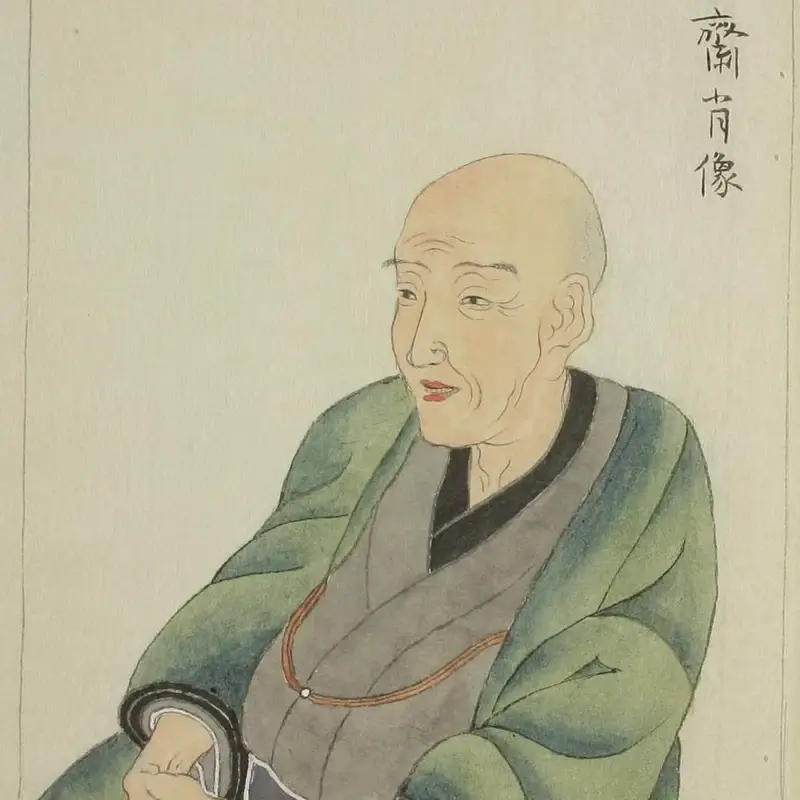
Katsushika Hokusai, a name synonymous with Japanese ukiyo-e art, is celebrated globally for his iconic work “The Great Wave off Kanagawa.” Born in October 1760 in Edo (now Tokyo), Hokusai embarked on an artistic journey deeply rooted in Japanese and Chinese painting traditions.
Early Life and Artistic Beginnings
Hokusai’s fascination with art began in childhood, influenced by his family background in craftsmanship. At age 12, he entered the workforce, working in a bookshop and later as a wood-carver’s apprentice. These experiences laid the foundation for his future in printmaking. At 18, he joined the studio of Katsukawa Shunshō, a master of the ukiyo-e style, which focused on images of city life, including courtesans and Kabuki actors. Under Shunshō’s guidance, Hokusai’s talent flourished, leading to his first published works in 1779, predominantly featuring Kabuki actors.
Rise to Fame: The Thirty-Six Views of Mount Fuji
The series “Thirty-Six Views of Mount Fuji,” created around the 1830s, marked a turning point in Hokusai’s career. This series, a response to Japan’s domestic travel boom and a personal obsession with Mount Fuji, includes the internationally renowned “The Great Wave off Kanagawa.” His innovative use of European perspective techniques and the introduction of Prussian blue paint revolutionized Japanese printmaking, earning him widespread recognition both in Japan and abroad.
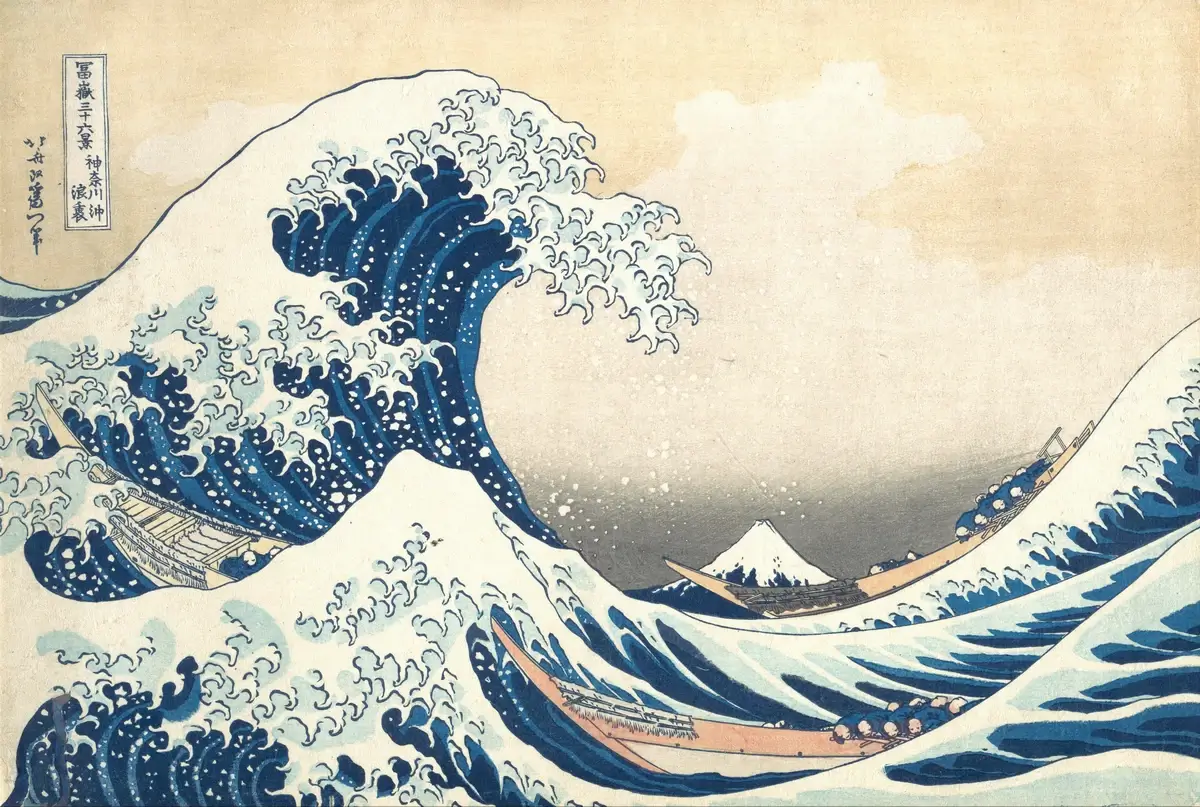
Katsushika Hokusai, “The Great Wave off Kanagawa”, 1831. Image: metmuseum.org
Artistic Innovations and Diverse Themes
Hokusai’s oeuvre extends beyond “The Great Wave,” showcasing his mastery in capturing nature’s intricacies and the delicacy of Japanese flora and fauna. Works like “Bullfinch and Weeping Cherry” and “Ducks in a Stream” exemplify his skill in blending formal realism with aesthetic elegance, pushing the boundaries of traditional Japanese art themes. His late works, such as “Li Bai Admiring a Waterfall” and “Old Tiger in the Snow,” highlight his continuous experimentation and innovation, even into his 80s.
Legacy and Influence
Hokusai’s legacy in the art world is profound, impacting not just ukiyo-e but the broader spectrum of world art. His relentless pursuit of artistic evolution and his curiosity in the natural world and its spiritual dimensions have left an indelible mark on the history of art.
2. Yayoi Kusama: Queen of Polka Dots
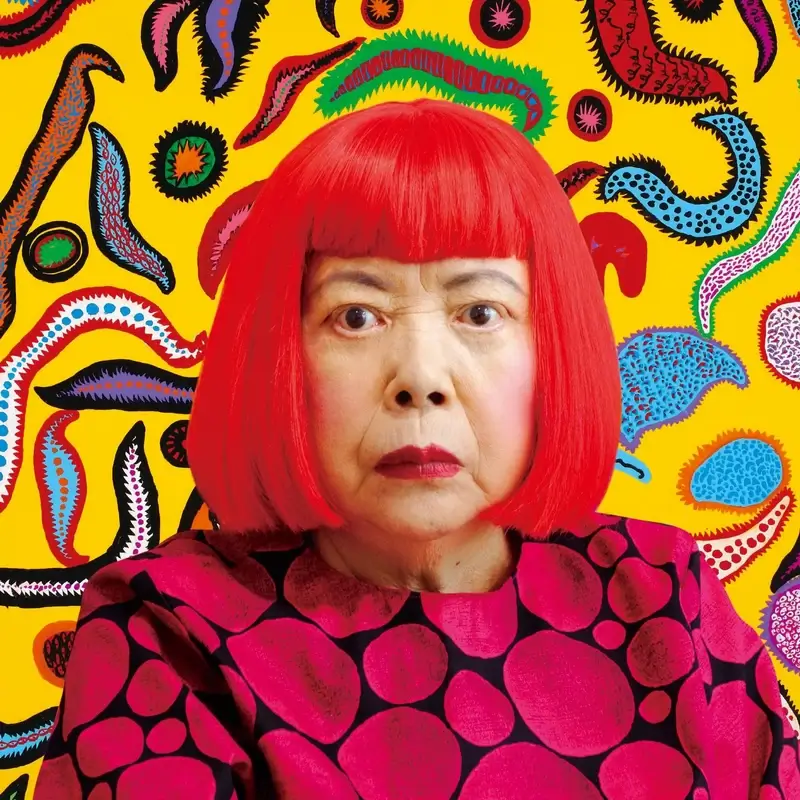
Yayoi Kusama, born on March 22, 1929, in Matsumoto, Japan, is an artist who has redefined the boundaries of contemporary art with her obsession for polka dots and infinity installations. Kusama’s journey in art, marked by her hallucinations involving fields of dots, began in her childhood. Her early experiences of mental health issues profoundly shaped her artistic style, leading her to create works that are both deeply personal and universally appealing.
From Japan to the New York Art Scene
After briefly studying Nihonga, a traditional Japanese painting style, Kusama moved to New York City in 1957, seeking a broader canvas for her artistic expression. In the bustling avant-garde scene of the 1960s, Kusama’s work evolved from her initial “Infinity Net” paintings, which were a radical departure from Abstract Expressionism, to her famous polka dot motifs that came to define her art. Her innovative approach to art blended various genres, including Pop art and Minimalism, and she became a prominent figure in the New York avant-garde community.
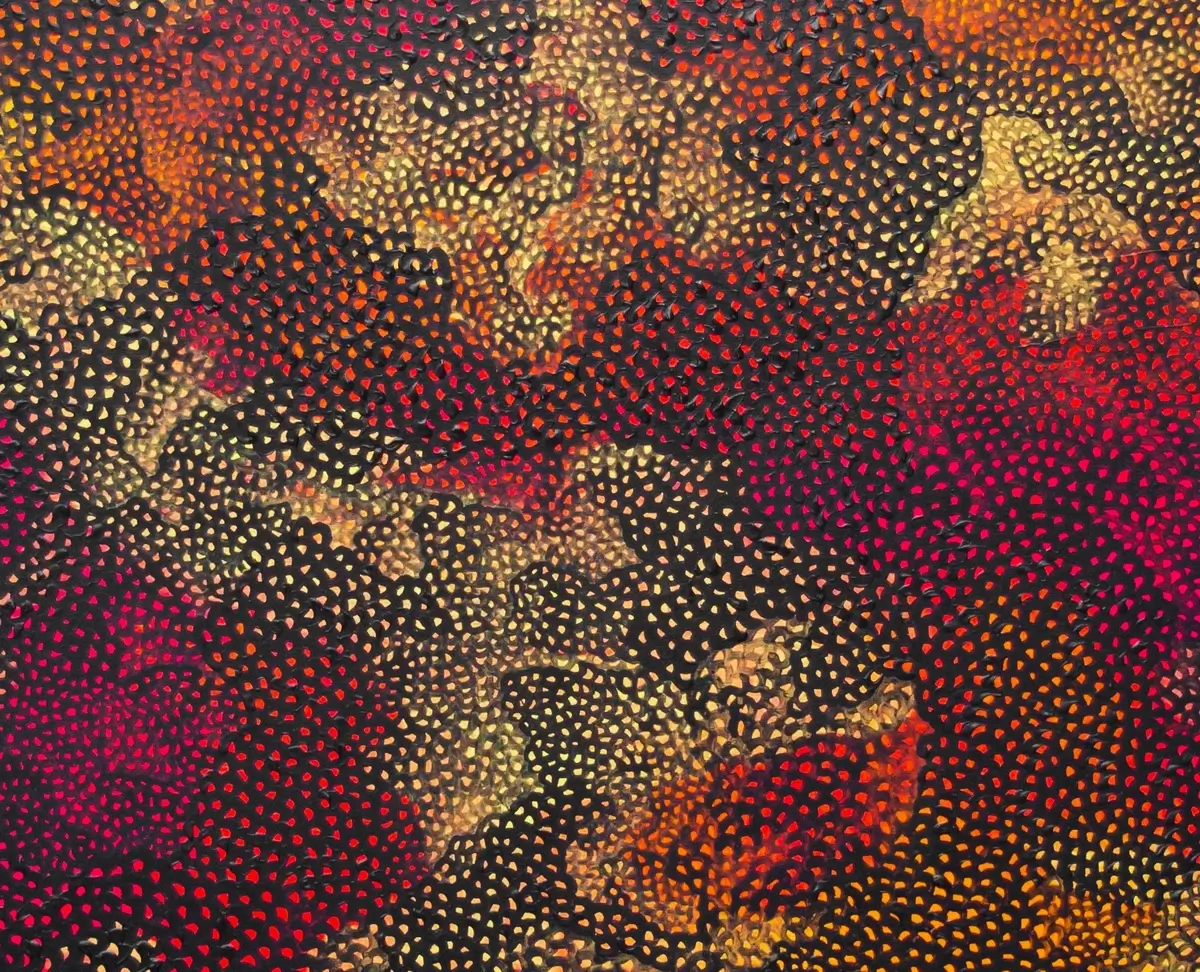
Yayoi Kusama, “Infinity Net” paintings. Image: artnet.com
Art as a Reflection of Personal Struggles
Kusama’s art is a powerful testament to her struggles with mental health. She has been candid about her experiences with hallucinations and mental illness, stating that creating art has been her way of coping with these challenges. Her work, often featuring repetitive patterns and engulfing environments, reflects her journey through mental health issues and her pursuit of personal and creative freedom.
Impact and Legacy
Kusama’s contributions to the art world are significant, with her work encompassing a wide array of mediums, including painting, sculpture, performance art, and installations. Her unique style and the use of polka dots have made her one of the most influential figures in contemporary art. Kusama’s “Infinity Mirror Rooms” and large-scale outdoor sculptures like “Pumpkin” are among her most celebrated works, showcasing her ability to transform her hallucinatory experiences into art that resonates with audiences worldwide.
3. Takashi Murakami: Superflat Revolution
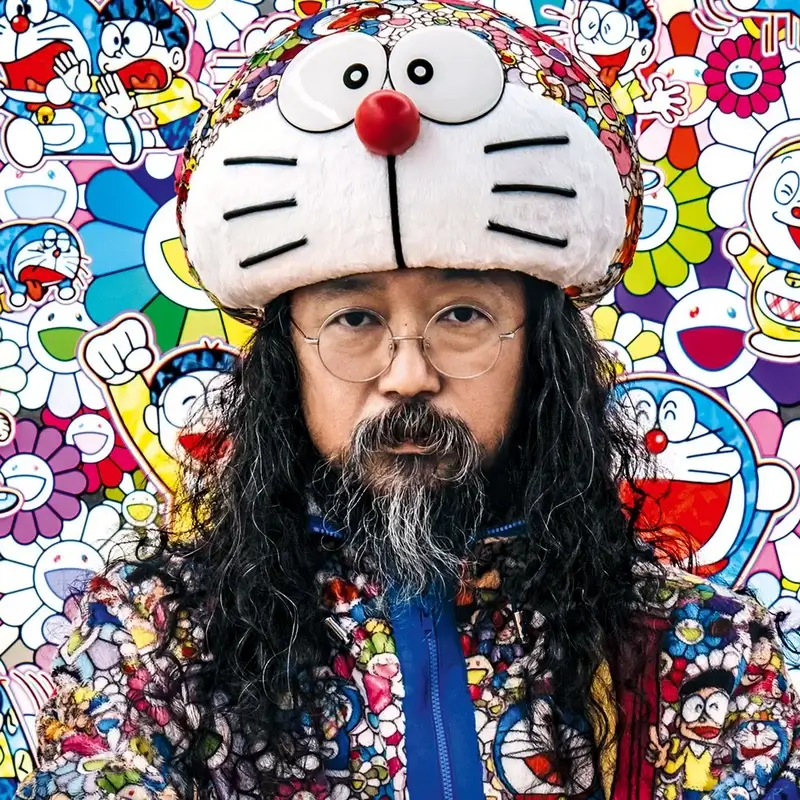
Takashi Murakami, born on February 1, 1962, in Tokyo, Japan, is an artist renowned for bridging the gap between high art and popular culture. His work is characterized by vibrant colors and bold imagery, a style that gave birth to the Superflat movement. This movement acknowledges and celebrates the interplay between commercial and art worlds, drawing heavily from Japanese traditional art and the contemporary aesthetics of anime and manga.
Emergence of Superflat
Superflat, a term coined by Murakami, reflects the legacy of flat, 2-dimensional imagery from Japanese art history, prevalent in manga and anime. This style contrasts with Western art’s emphasis on dimension and depth. Superflat also comments on postwar Japanese society, suggesting a cultural landscape where social class and popular taste have ‘flattened,’ blurring distinctions between ‘high’ and ‘low’ art. Murakami’s exhibitions, like “Coloriage” (2002) and “Little Boy: The Arts of Japan’s Exploding Subculture” (2005), have been pivotal in showcasing Japan’s creative culture globally.
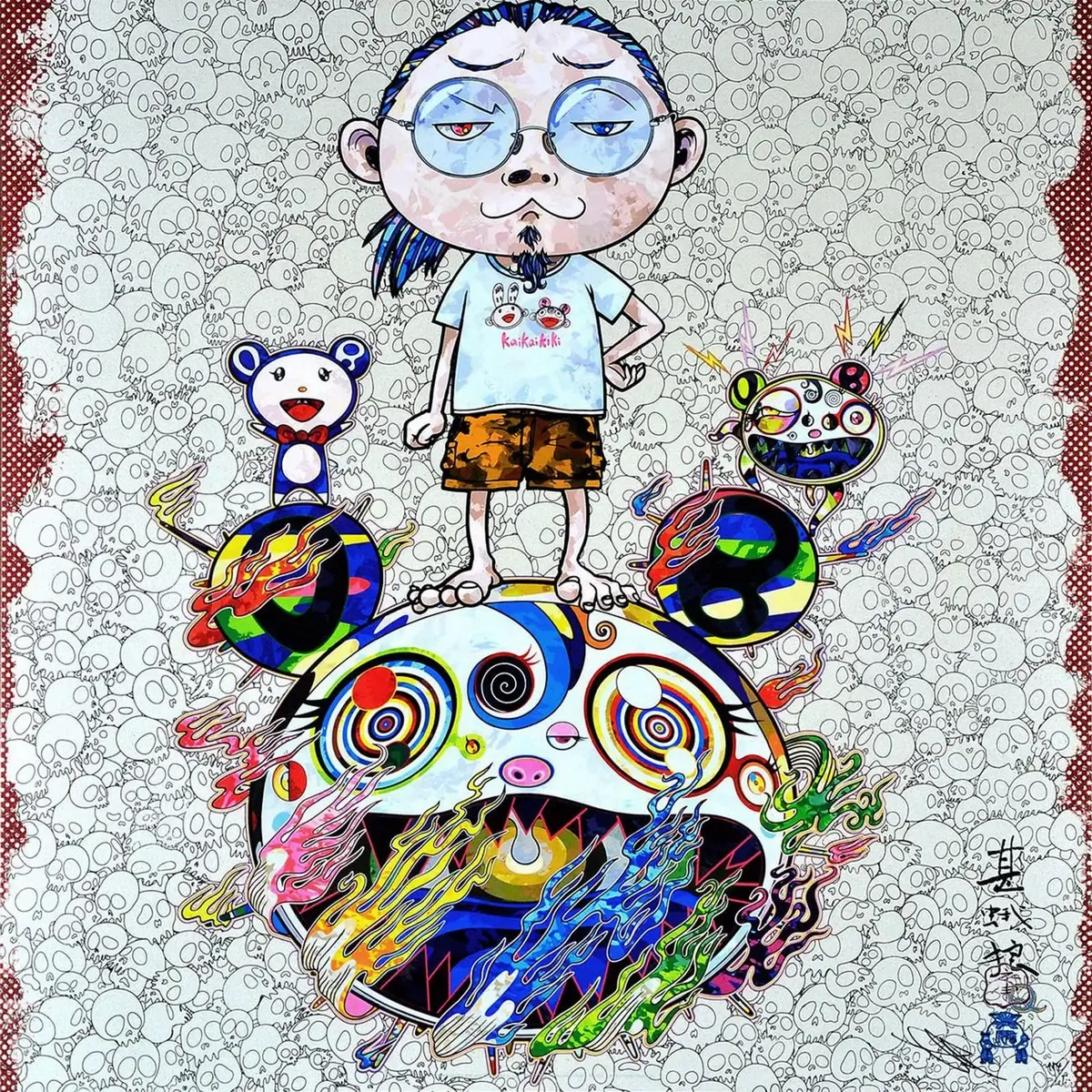
Takashi Murakami, “Obliterate the Self and Even a Fire is Cool”, 2013. Image: fineartmultiple.com
Artistic DNA and Global Influence
Murakami’s art extends beyond canvas to include large-scale sculptures and commercial collaborations, blurring the lines between fine arts and popular media. His iconic character, Mr. DOB, reflects this melding of artistic DNA across mediums, from paintings to commercial merchandise. Murakami’s work, influenced by his exposure to Western contemporary artists in New York, embodies a critique and celebration of consumer culture, both in Japan and globally.
Collaborations and Commercial Success
Murakami’s collaboration with fashion brands and musicians like Louis Vuitton and Kanye West exemplifies his approach to art as a blend of commercial and high art. These partnerships have not only brought him international fame but also challenged the boundaries between artistic mediums. His work with Louis Vuitton, for instance, reimagined the brand’s classic monogram, making high art accessible through fashion.
Takashi Murakami’s Superflat Revolution represents a unique fusion of traditional Japanese aesthetics with contemporary pop culture, reshaping how we perceive art in the modern world.
4. Hiroshige: Master of Ukiyo-e Landscapes
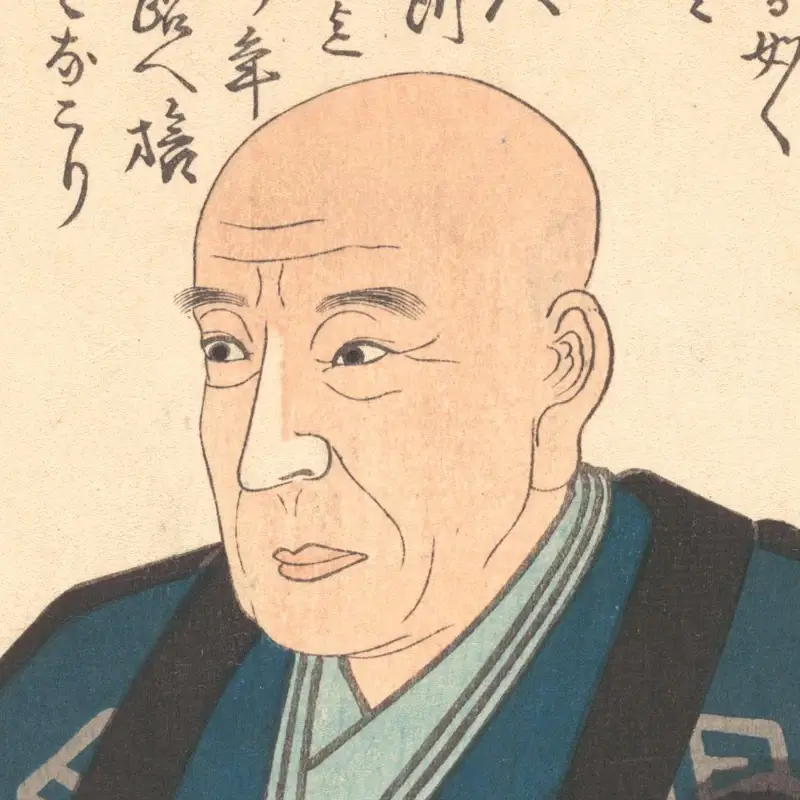
Utagawa Hiroshige, born in 1797 in Edo (now Tokyo), is celebrated as one of the last great masters of the ukiyo-e woodblock print genre. His artistry is particularly renowned for its landscape compositions, which gained recognition in the West by Impressionists and Post-Impressionists.
Innovations in Ukiyo-e
Hiroshige’s work was unique within the ukiyo-e genre, traditionally focused on beautiful women, popular actors, and urban pleasure districts. His landscapes, such as the “Fifty-three Stations of the Tōkaidō” and “One Hundred Famous Views of Edo,” were inspired by Hokusai’s “Thirty-six Views of Mount Fuji,” yet Hiroshige’s approach was more poetic and ambient. His adept use of color, often with multiple impressions in the same area and extensive use of bokashi (color gradation), was labor-intensive but resulted in evocative and atmospheric works.
A Fusion of Japanese and European Influences
Hiroshige skillfully combined Japanese and European influences in his prints. For instance, in “Kinryūzan Temple, Asakusa,” he employed central perspective, a technique introduced to Japan through European books, to create depth. This, along with his lyrical portrayal of subjects, such as the serene, snow-covered temple, demonstrated his ability to evoke mood and atmosphere.

Utagawa Hiroshige, “Plum Estate, Kameido”, 1857. Image: Wikimedia Commons
Legacy and Western Influence
Hiroshige’s death in 1858 marked a turning point in ukiyo-e, coinciding with Westernization trends following the Meiji Restoration. His works significantly influenced Western European painting in the late 19th century as part of the Japonism movement. Artists like Manet, Monet, and Vincent van Gogh closely studied and were inspired by Hiroshige’s compositions.
Hiroshige’s art captures the ephemeral beauty of nature and the Japanese landscape, creating a lasting impact on both Eastern and Western art.
5. Tadanori Yokoo: The Japanese Warhol
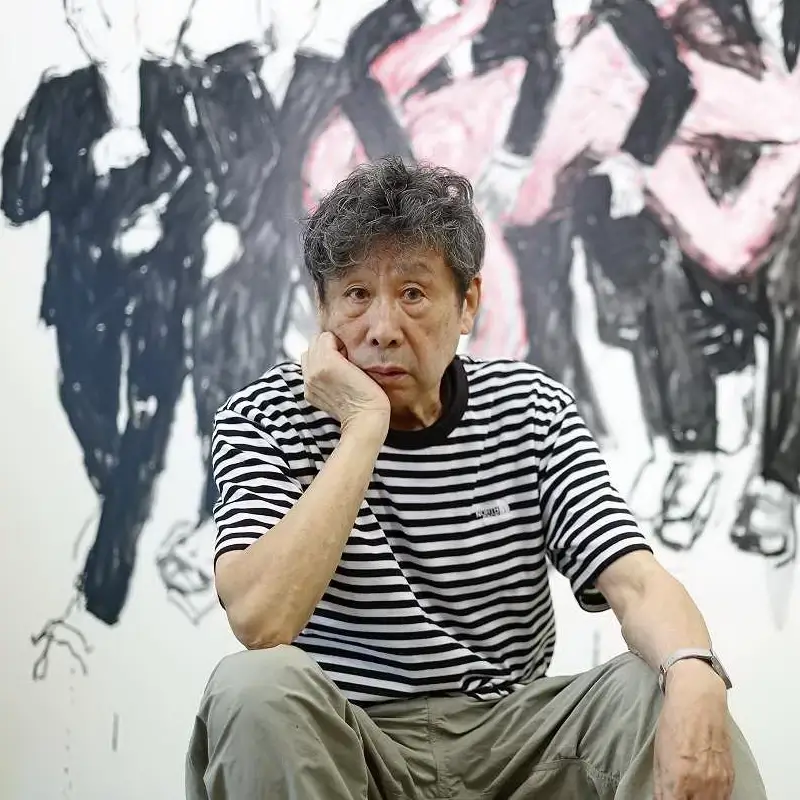
Tadanori Yokoo, born in 1936 in Nishiwaki, Hyōgo Prefecture, Japan, stands out as one of the most prominent graphic designers and artists in post-war Japan. His meteoric rise in the art world began in 1965 with his participation in the Persona exhibition in Tokyo. Yokoo’s style, often compared to Andy Warhol, is renowned for its vibrant collage aesthetics and deep engagement with cultural and political themes.
A Breakthrough in Artistic Expression
Yokoo’s early work, particularly the self-portrait poster “Tadanori Yokoo” (1965), marked a significant departure from the prevailing abstract design trends in Japan at the time. This poster, featuring imagery of Yokoo hanging himself and juxtaposed with nationalistic symbols like the rising sun and Mt. Fuji, was both a personal rebirth and a critique of Western modernism’s influence in Japan and the nation’s rapid economic growth.
Collaborations and Expanding Horizons
Throughout the 1960s and 1970s, Yokoo’s collaborations spanned various fields, including stage design for avant-garde theatre and album covers for musicians. His work for the Ankoku Butoh dance company and various international rock bands showcased his ability to fuse the sexual, political, historical, and modern in a uniquely Japanese context.
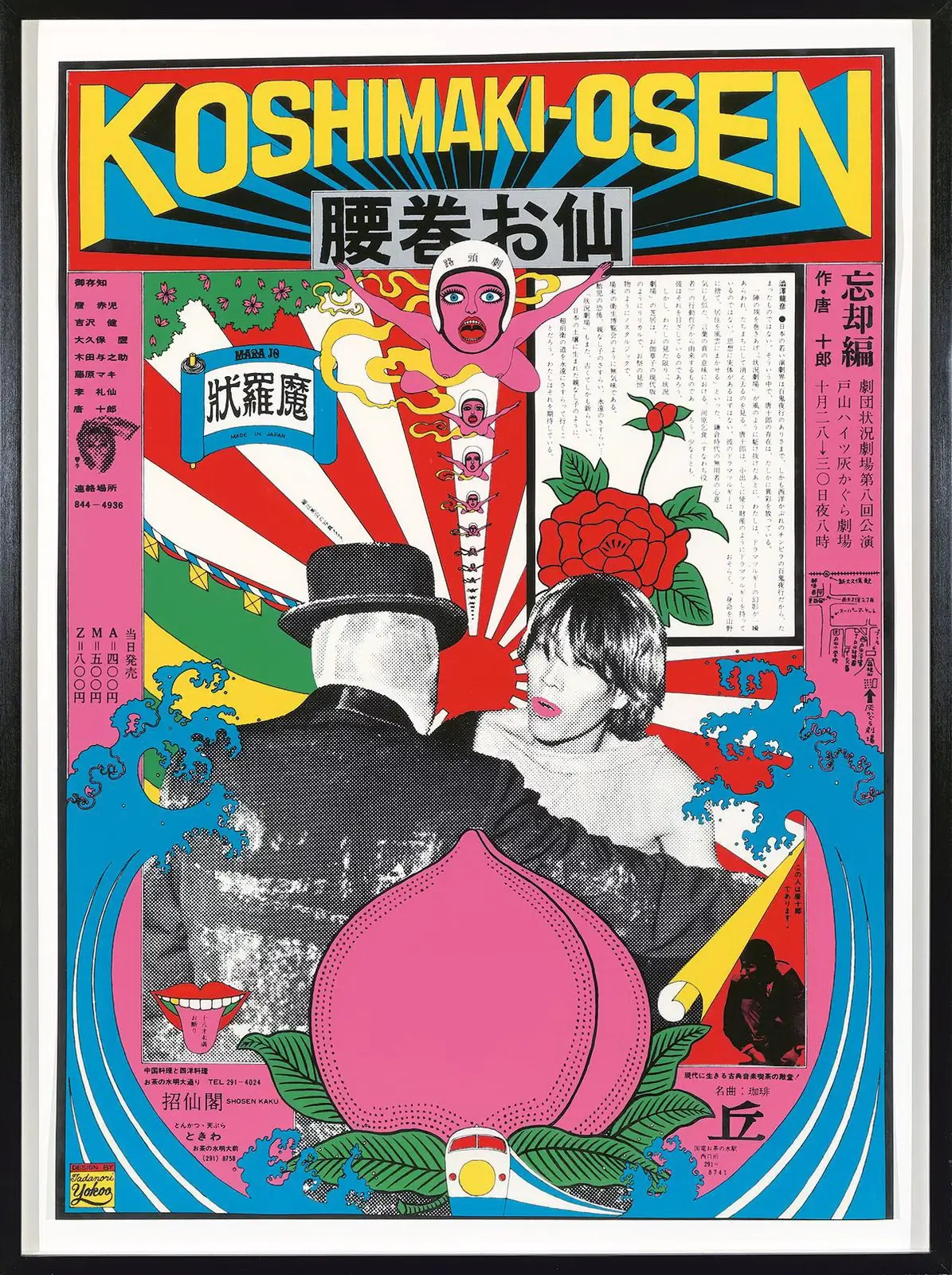
Tadanori Yokoo, “Koshimaki-Osen”, 1966. Image: posterauctions.com
Recognition and Shift in Career
By the late 1960s, Yokoo had gained international recognition, culminating in a solo exhibition at the Museum of Modern Art in New York in 1972. However, in a surprising move, he “retired” from commercial work in 1981 and shifted his focus to painting, following a Picasso retrospective at MoMA. Since then, he has continued to be active in both painting and graphic design.
Tadanori Yokoo’s work, with its autobiographical elements and originality, transcends the simplistic comparison to Western artists, firmly establishing him as a unique voice in the world of art.
6. Yoshitomo Nara: The Innocence and Angst of Childhood
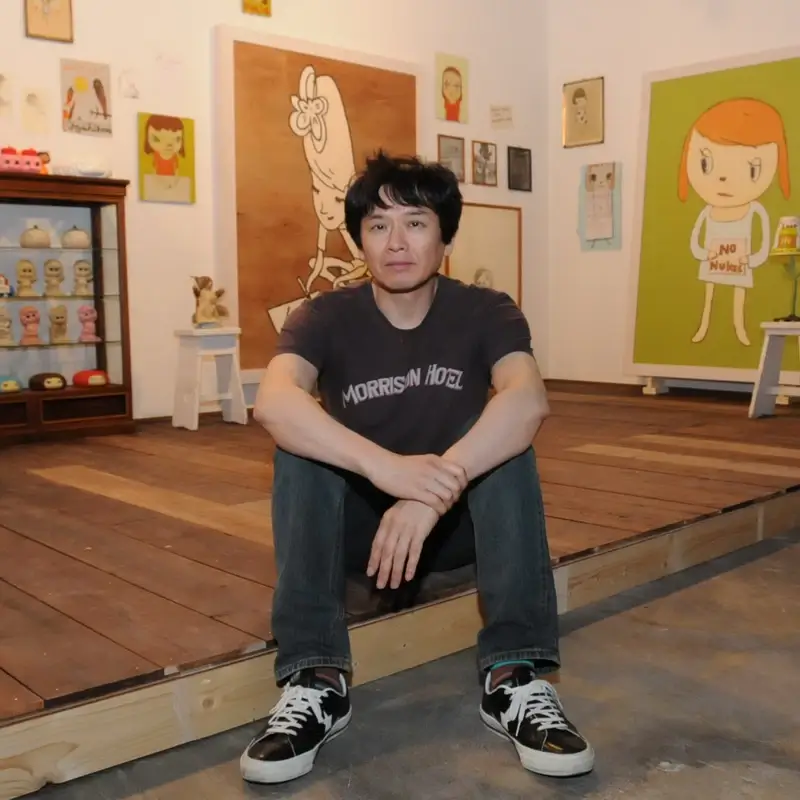
Yoshitomo Nara, a prominent Japanese artist born in 1959, is widely recognized for his distinctive style that intertwines the innocence of childhood with a sense of rebellion and angst. His work, often featuring stylized, large-eyed figures, reflects the influence of manga and anime from his 1960s childhood, albeit with a twist of horror-like imagery. This unique juxtaposition in Nara’s art could be seen as a response to the rigid social conventions in Japan.
Musical Influences and Artistic Development
Nara’s artistic expression is deeply influenced by the punk rock music of his youth, an element that resonates through his rebellious themes. His upbringing in post-World War II Japan, a period marked by an influx of Western pop culture, also profoundly shaped his mindset and art. Nara grew up as a latchkey child in the isolated countryside, a background that fostered his fiercely independent and introspective art subjects.
Shift Toward Meditative Work
In recent years, Nara’s work has undergone a shift towards more meditative themes. Exhibitions like “Thinker” at the Pace Gallery in New York in 2017 and retrospectives of his work display this transition, showcasing a softer, more reflective side of his artistry, contrasting with the more defiant tone of his earlier works.
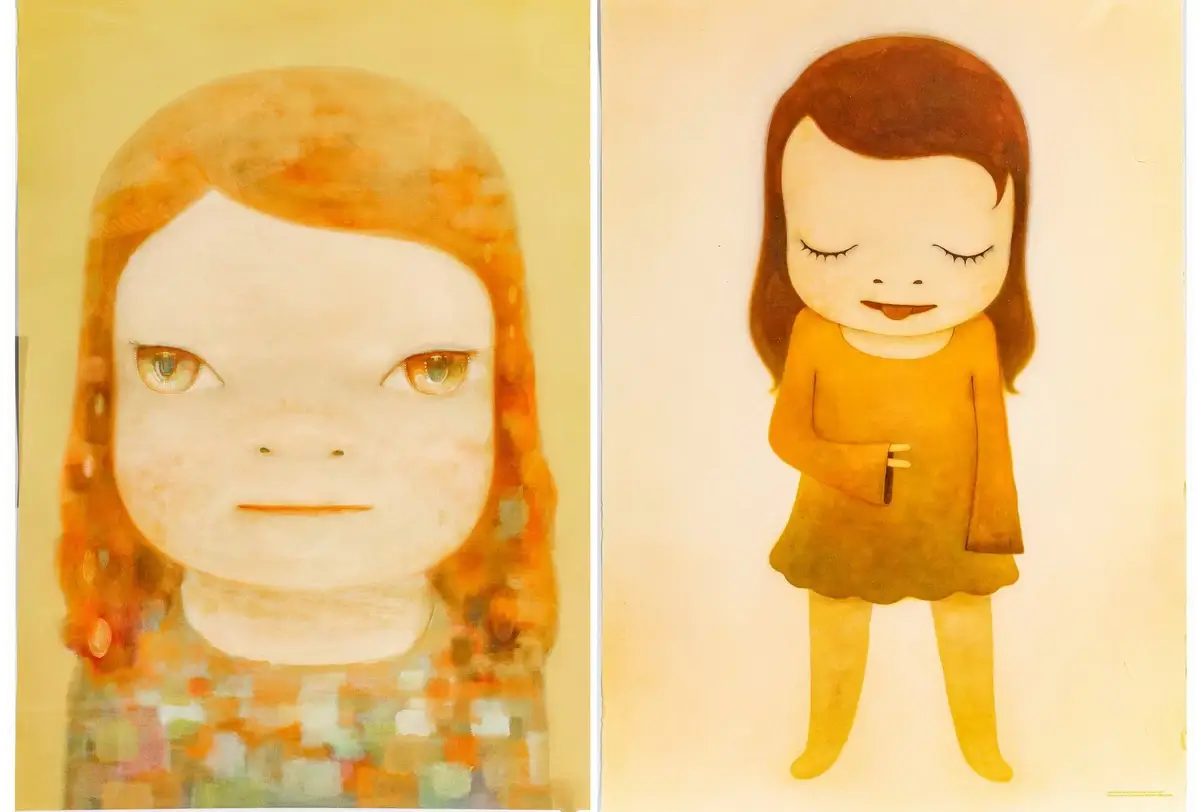
Yoshitomo Nara, “Hazy Humid Day; Jolie the Little Thinker”, 2021. Image: dumoart.com
Exploring Themes of Youth and Rebellion
Nara’s work often portrays complex emotions and navigates ideas of youth, rebellion, and identity in contemporary society. His use of child and animal figures as symbols of loneliness, fragility, and innocence, alongside motifs like closed eyes, reflect a more introspective period in his career. These elements collectively signify a deeper exploration of the emotional landscapes of childhood and adolescence.
Yoshitomo Nara’s art provides a unique lens into the world of contemporary Japanese art, blending traditional influences with modern pop culture to create a narrative that is both personal and universally resonant.
7. Mariko Mori: Futuristic and Spiritual Explorations

Mariko Mori, born in 1967, is a Japanese multidisciplinary artist recognized for her integration of pop culture, religion, and technology in her artworks. Her innovative approach in art explores the universal, the fantastic, and the notion of otherness.
Early Artworks and Evolution
In her early works during the 1990s, Mori often featured herself as the main protagonist, portraying cyborg or alien-like heroines in urban settings. Her performances and photographs, like “Play with Me” (1994) and “Tea Ceremony” (1995), drew parallels with manga characters and juxtaposed Japanese stereotypes of submissive women. As her career progressed, she began incorporating religious iconography, moving towards more interactive and immersive experiences. For instance, her 3D film “Nirvana” (1996–1997) portrays her as Kichijoten, a Japanese Buddhist goddess.
Oneness and Rebirth
Mori’s work “Oneness” (2003), initially exhibited at Deitch Projects, New York, features six alien sculptures made from skin-like material that illuminate when hugged. This piece, along with others like “Wave UFO,” demonstrates her skill in using advanced technology to create mystic and UFO-inspired artworks. “Rebirth,” a solo exhibition first shown in London, signified a major departure from her earlier works, delving into ancient cultures and universal values. It included installations like “Transcircle 1.1” (2004) and “Flatstone” (2006), inspired by Celtic stone circles and Jōmon temples.
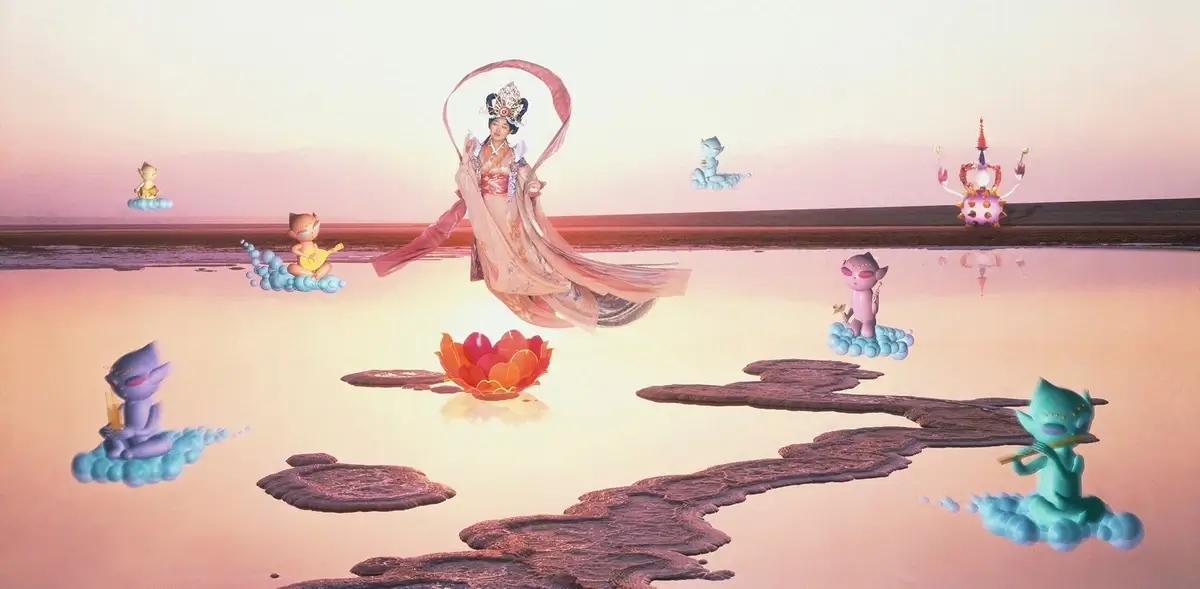
Mariko Mori, “Pure Land”, 1998. Image: khanacademy.org
Integration of Technology in Art
Mariko Mori’s art is known for its seamless integration of technology, nature, and spirituality. Her works, such as “Ekpyrotic String VI” (2016–2017), displayed at her solo exhibition “Invisible Dimension” at Sean Kelly, New York, in 2018, are inspired by astrophysical theories and reflect a profound understanding of the universe’s cyclic nature.
Recognition and Influence
Mori’s contributions to the art world have been recognized globally, including receiving a Menzione d’onore at the Venice Biennale for her work “Nirvana” (1997). Her artistic vision has inspired a new perspective in contemporary art, blending art with science and spirituality.
Mariko Mori continues to redefine the boundaries of contemporary art, with her works housed in major art institutions like the Los Angeles County Museum of Art and The Museum of Modern Art, New York. Her art remains a source of inspiration for embracing technology and exploring the interconnectedness of our universe.
8. Shinro Ohtake: Eclectic Maximalism in Art
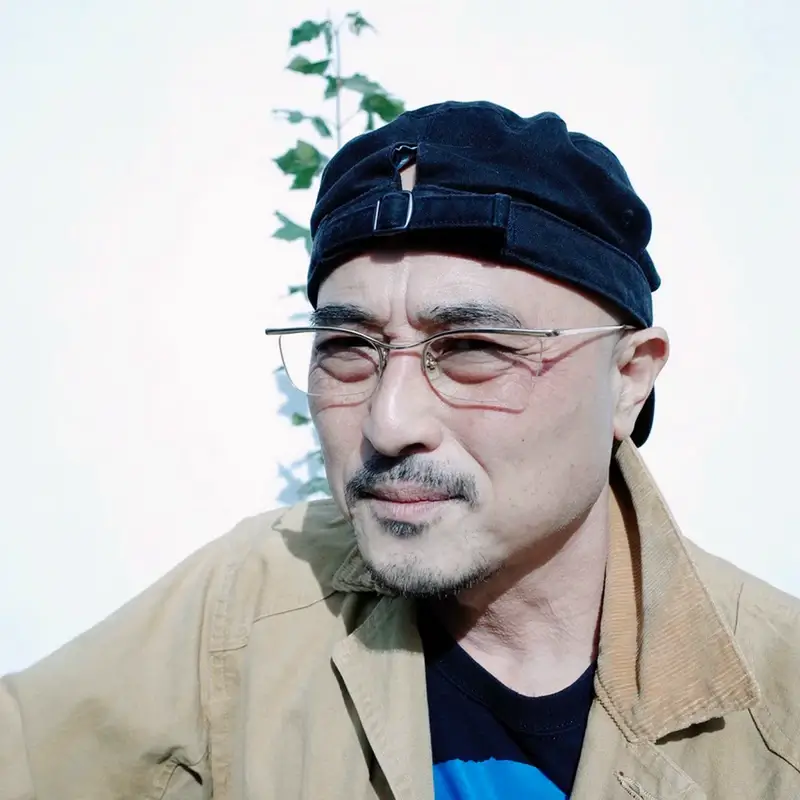
Shinro Ohtake, born in 1955 in Tokyo, Japan, is a multi-faceted artist whose work spans across a variety of mediums, including drawings, collages, paintings, large-scale assemblages, and even architectural projects. He is notably recognized as one of Japan’s leading contemporary artists.
A Journey Through Visual and Material Culture
Ohtake’s journey in the arts is marked by his experimental approach, particularly evident in his heavily collaged scrapbooks. These works, initiated in 1977, form the core of Ohtake’s practice. In these scrapbooks, he intricately assembles found materials from daily life, creating complex fragmentary compositions on each page, which are then enriched with hand-drawn and painted elements. Over time, these books evolve into objects that embody both sculptural and organic qualities, offering a unique exploration of memory and time.
Influences and Artistic Evolution
Ohtake’s time in London during the late 1970s, at the height of the punk movement, played a crucial role in shaping his artistic ethos. The punk movement’s experimental nature, along with influences from Dada, Surrealism, Pop Art, and artists like David Hockney, have significantly impacted his work. These influences are evident in his multifaceted approach to art-making, which blurs the lines between traditional art forms.
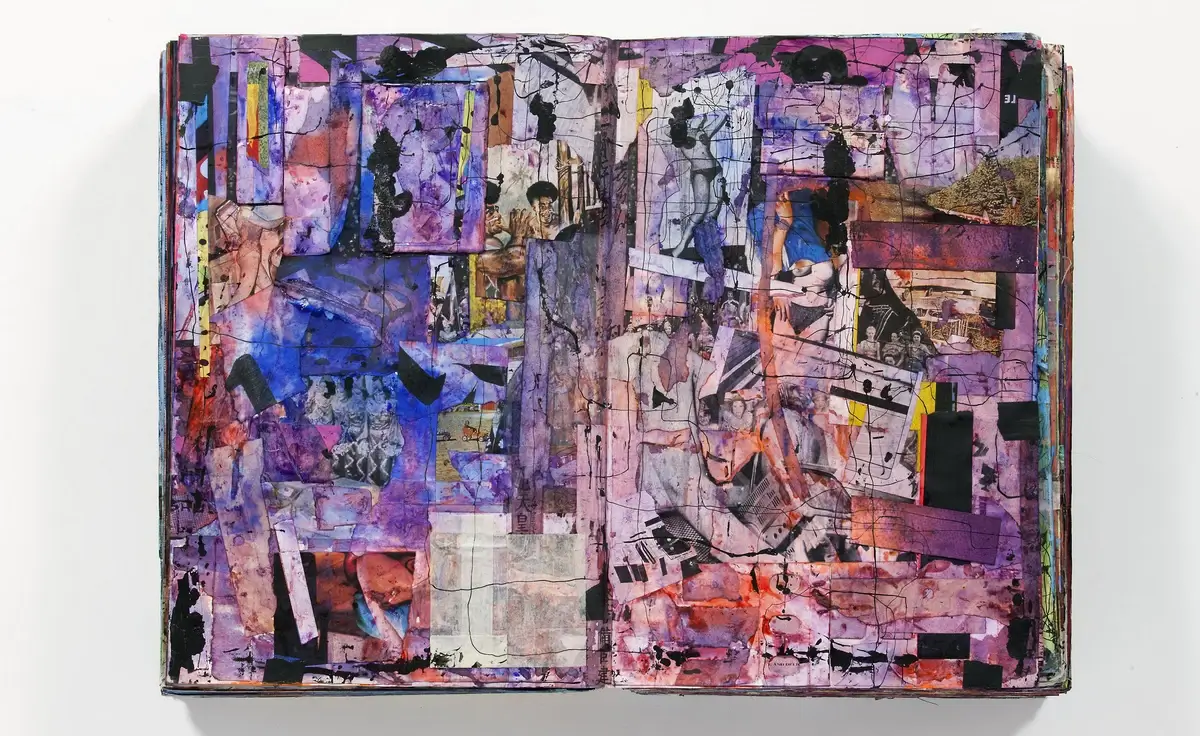
Shinro Ohtake, “Scrapbook #66”, 1977. Image: wallpaper.com
Architectural Endeavors and Musical Experiments
Besides his visual arts practice, Ohtake has made significant contributions to Japan’s experimental music scene and has undertaken notable architectural projects. His design of the public bathhouse and art facility “Naoshima Bath ‘I Love Yu'” on Naoshima Island integrates architectural pastiche with sculptural and collaged imagery, showcasing popular culture as a collective memory space.
Exhibitions and Recognition
Ohtake’s works have been featured in prominent exhibitions, including the Venice Biennale’s “Encyclopaedic Palace” in 2013 and documenta 13. His scrapbooks, in particular, received a complete presentation at the 2013 Venice Biennale, highlighting their significance within his body of work.
Shinro Ohtake’s artistic journey is a testament to his relentless exploration of materiality, form, and the impact of contemporary visual culture on human experience and identity.
9. Makoto Aida: The Provocateur of Contemporary Art
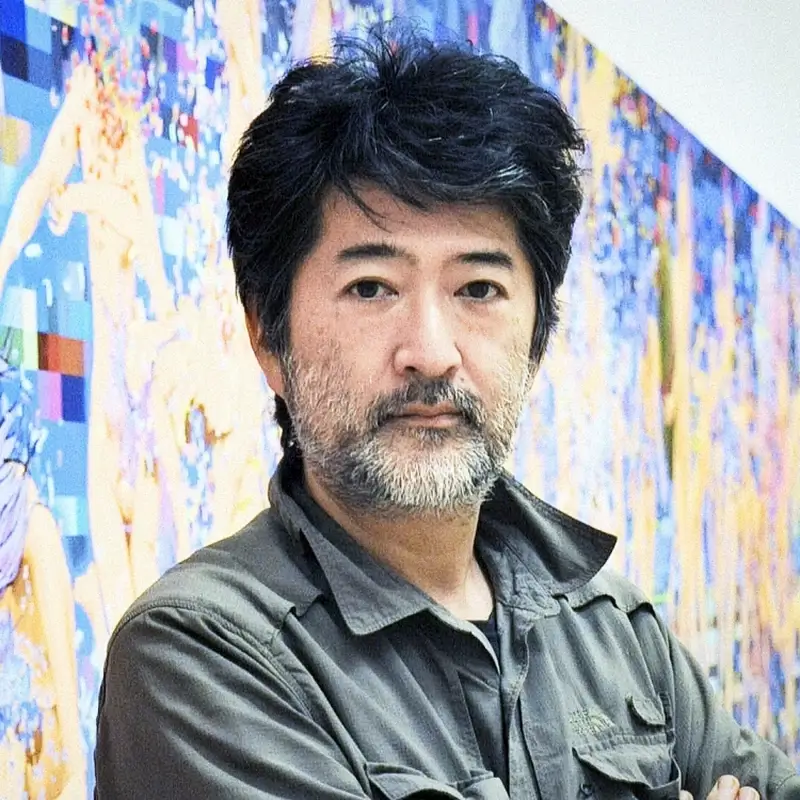
Makoto Aida, born in 1965 in Niigata Prefecture, Japan, is a distinguished figure in the Japanese contemporary art scene, known for his provocative and diverse body of work. His art spans multiple genres, including manga, painting, video, photography, sculpture, and installation. Aida’s approach to art often challenges social norms and pushes the boundaries of conventional artistic expression.
A Multifaceted Artistic Journey
Aida’s artistic journey has been marked by a continuous exploration of various themes and mediums. He is renowned for addressing complex social issues such as the sexual objectification of schoolgirls and violent nationalism in his work. His art is a reflection of his critical perspective on contemporary Japanese society, politics, and history.
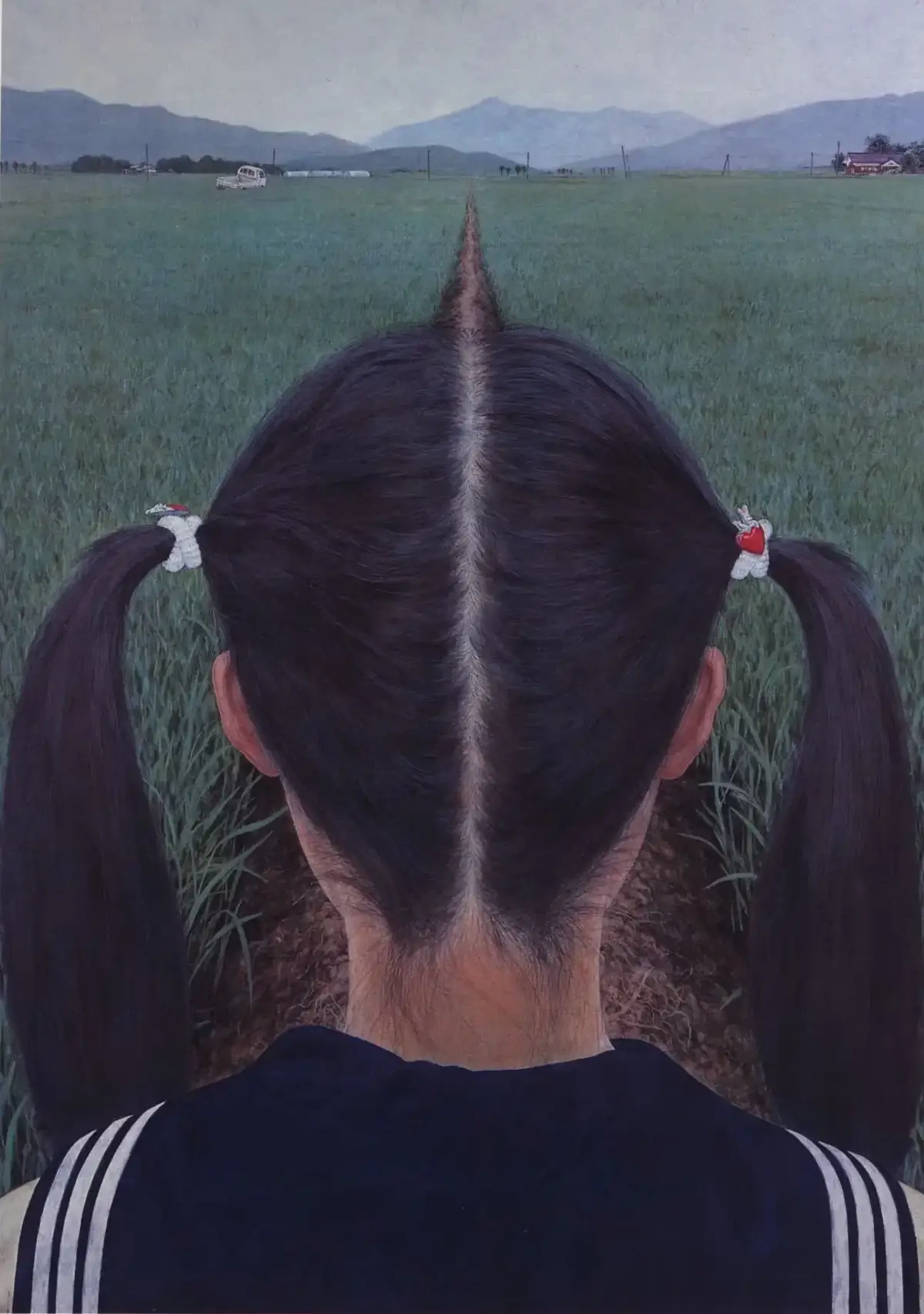
Makoto Aida, AZEMICHI (a path between rice fields), 1991. Image: mandarake.co.jp
Breaking Conventions
Aida’s work stands out for its ability to confront and critique the status quo. His provocative nature has established him as a significant voice in the art world, often compared to other prominent Japanese artists like Takashi Murakami and Yoshitomo Nara. However, Aida’s unique style and bold thematic choices set him apart as an influential contemporary artist in his own right.
10. Ayako Rokkaku: Joy in Spontaneous Painting
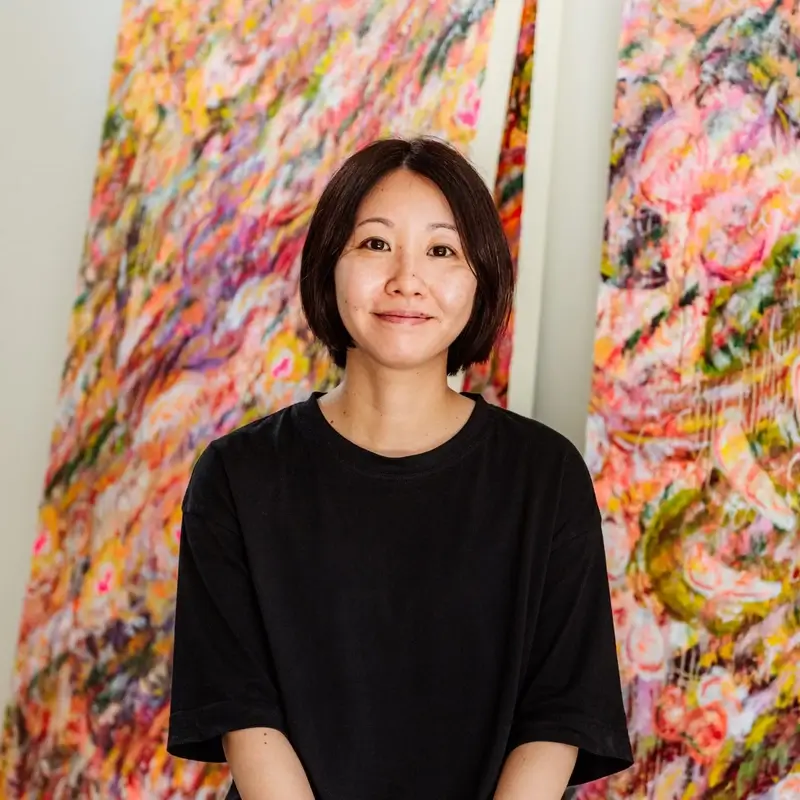
Ayako Rokkaku, born in 1982 in Chiba, Japan, is a self-taught artist renowned for her exuberant and dreamlike paintings, which have captivated audiences globally. Her work is a vibrant testimony to the power of a child’s imagination, expressed through her unique and spontaneous painting style.
Embracing Spontaneity and Imagination
Rokkaku’s paintings are distinguished by their intense, rainbow-toned color palette filled with pinks, yellows, blues, and greens. Her art commonly features flowers, illustrations of female characters, and cats, all imbued with a childlike, dreamy, and impressionistic quality. The characters in her paintings are stylized with large eyes and long limbs, reminiscent of Japanese manga, and they often depict scenes of frolicking in fields, resting, or dancing.
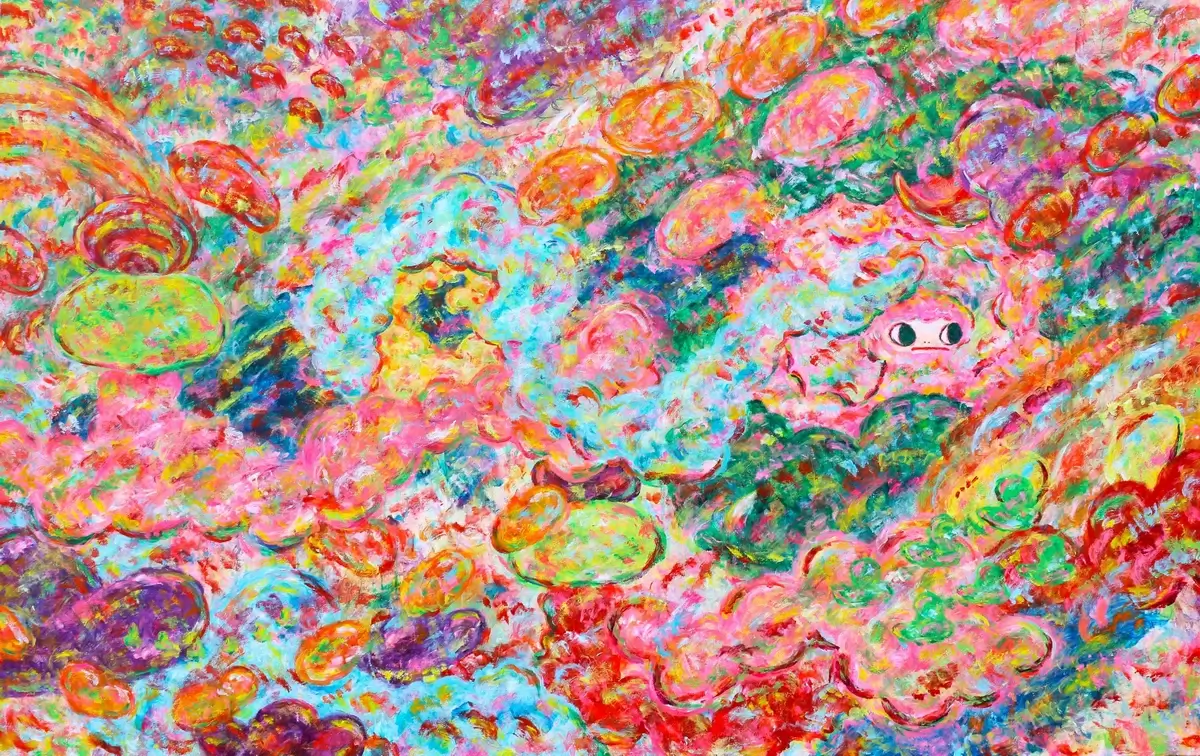
Ayako Rokkaku, Untitled, 2021. Image: prnasia.com
A Unique Artistic Process
What sets Rokkaku apart is her distinctive approach to creating art. She often paints on large-scale canvases, some as wide as 23 feet, using only her fingertips. This method infuses her work with a dynamic, organic quality that distinguishes her from other contemporary artists. Her process becomes performative, as she frequently paints in front of an audience, guided purely by intuition without preliminary sketches. Rokkaku’s choice of materials extends beyond canvas, utilizing cardboard, acetate, and even vintage Louis Vuitton suitcases.
Recognition and Exhibitions
Since winning the Illustration Prize at Kaikai Kiki’s Geisai art fair in 2003, Rokkaku has risen to international prominence. Her work has been featured in solo exhibitions in various countries, including the Netherlands, Denmark, Germany, and Slovakia, and often fetches high prices in the art market.
Rokkaku’s joyful, spontaneous art is a celebration of imagination and the boundless creativity of the human spirit.
11. Sanzo Wada: Pioneer in Color Theory
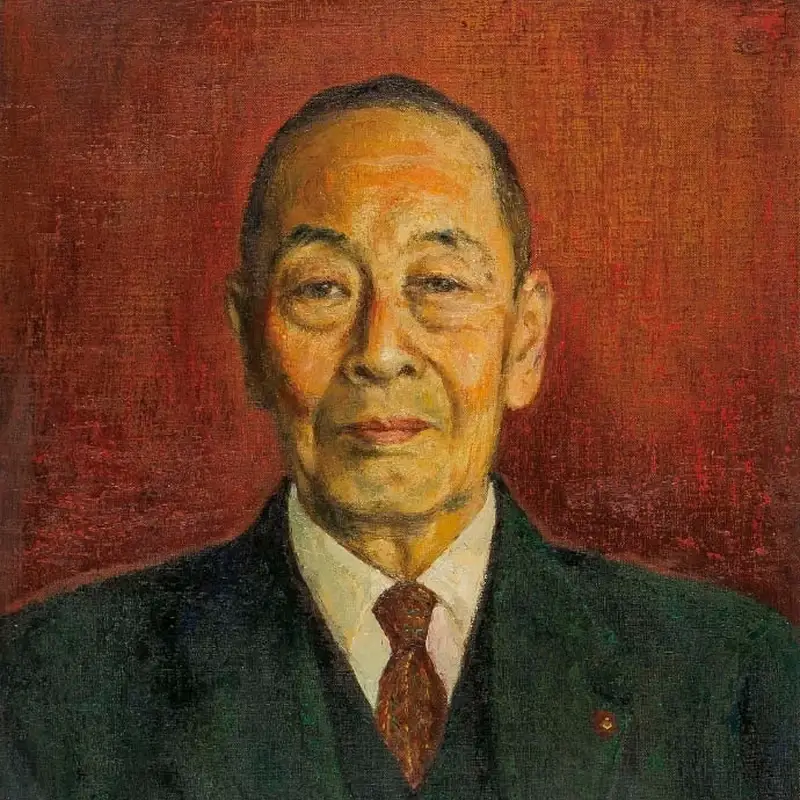
Sanzo Wada (1883-1967) was a Japanese artist, teacher, and researcher who dedicated his life to the study of color theory, making significant contributions that resonate even today. Wada’s approach to color was unique for its time, blending traditional Japanese sensibilities with Western color theory. He was deeply interested in the emotional and cultural connotations of colors and their interrelationships, exploring these themes in various artistic mediums such as painting, printmaking, and textile design.
Innovations in Color Research
Between 1933 and 1934, Wada published a six-volume study titled “Haishoku Soukan,” documenting over a thousand color combinations. This work was revolutionary in capturing the traditional Japanese perception of color, which markedly differed from Western approaches. The collection included a wide range of subtle shades and hues, reflecting the depth and complexity of Wada’s understanding of color.
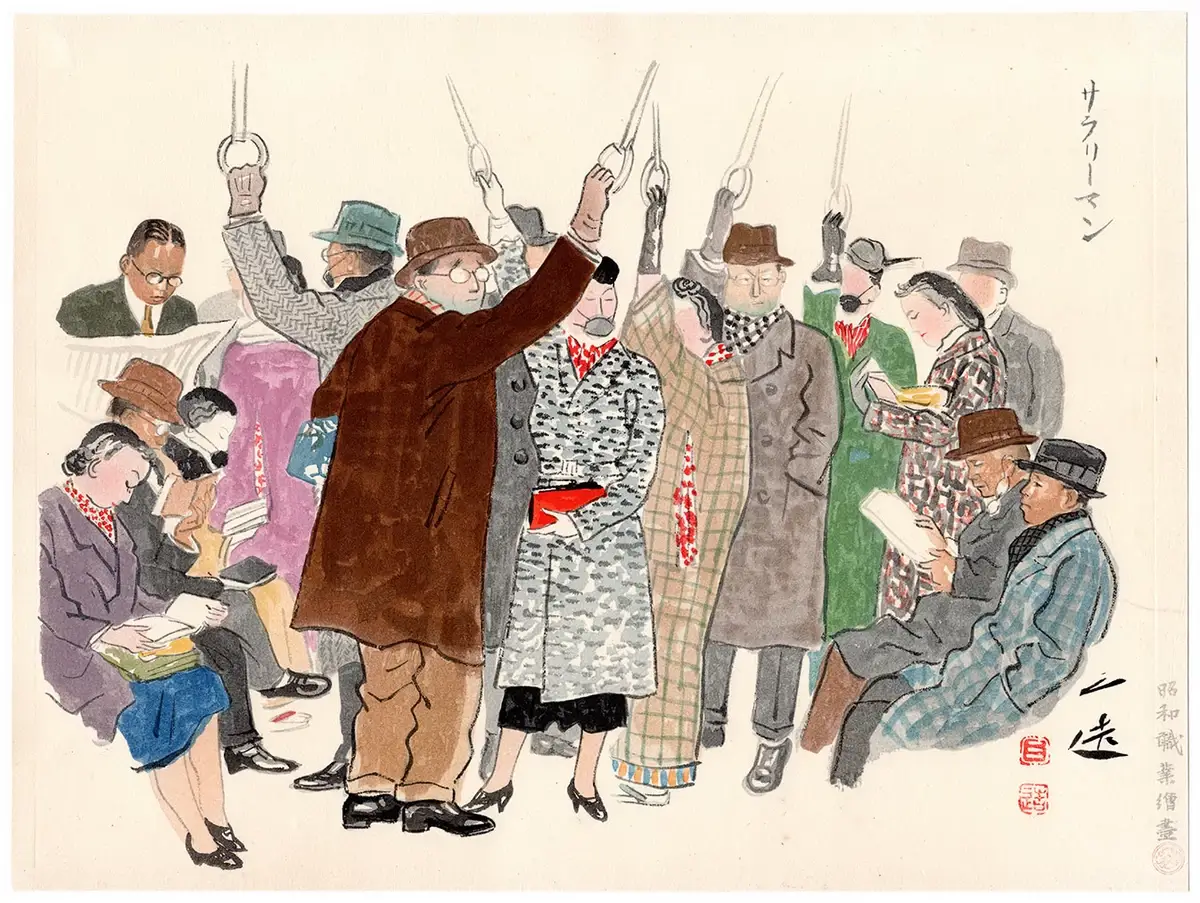
Sanzo Wada, SALARYMAN, 1940. Image: miwajapaneseart.com
Legacy in Modern Design
Wada’s work had a profound impact on the development of modern graphic design in Japan. His teachings and philosophy continue to influence designers and artists worldwide. “A Dictionary of Color Combinations,” published by Seigensha in 2011, is based on his original six-volume work and contains 348 color combinations. This book, along with its subsequent volume, remains a vital resource for understanding color harmony and design.
Wada Sanzo’s pioneering work in color theory established him as a visionary in the field, and his insights continue to be studied and applied across various disciplines today.
12. Yoko Ono: A Fusion of Art and Activism
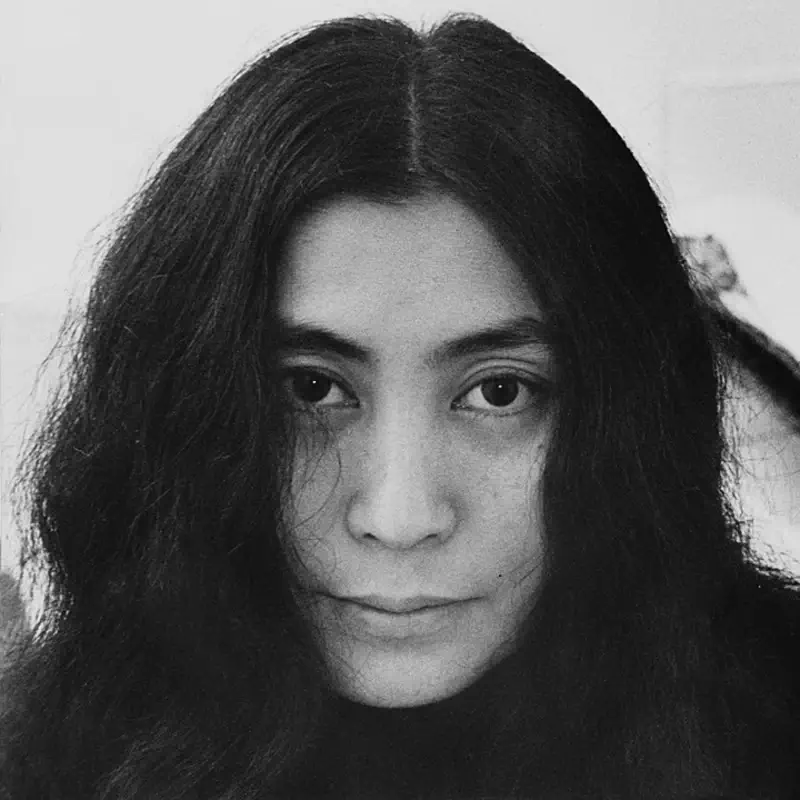
Yoko Ono, a name synonymous with avant-garde art and cultural activism, stands as a monumental figure in the landscape of modern art. Born on February 18, 1933, in Tokyo, Japan, Ono’s journey from a privileged upbringing to a revolutionary artist in New York City embodies a narrative of creativity, resilience, and boldness.
Early Life and Artistic Beginnings
Raised in Tokyo in an affluent family, Ono’s artistic journey began early. Her childhood was steeped in creativity, with pursuits in poetry and classical music. This foundation was pivotal when she moved to New York in the 1950s, where she attended Sarah Lawrence College. However, it was her immersion in the avant-garde art scene, rather than traditional education, that defined her artistic path. By 1960, her Manhattan loft became a hotbed for performance art, hosting influential figures like La Monte Young and John Cage.
Pioneering Performances and Conceptual Art
1964 marked a significant year for Ono with the debut of “Cut Piece” in Kyoto. This performance, where she sat motionless as the audience cut pieces of her clothing, was a powerful commentary on vulnerability and gender. The same year, “Grapefruit,” a book of instructions blending art with daily life, emerged, urging readers to engage with their environment in imaginative ways. These works exemplified Ono’s commitment to breaking down barriers between art and life, a hallmark of the Fluxus movement.
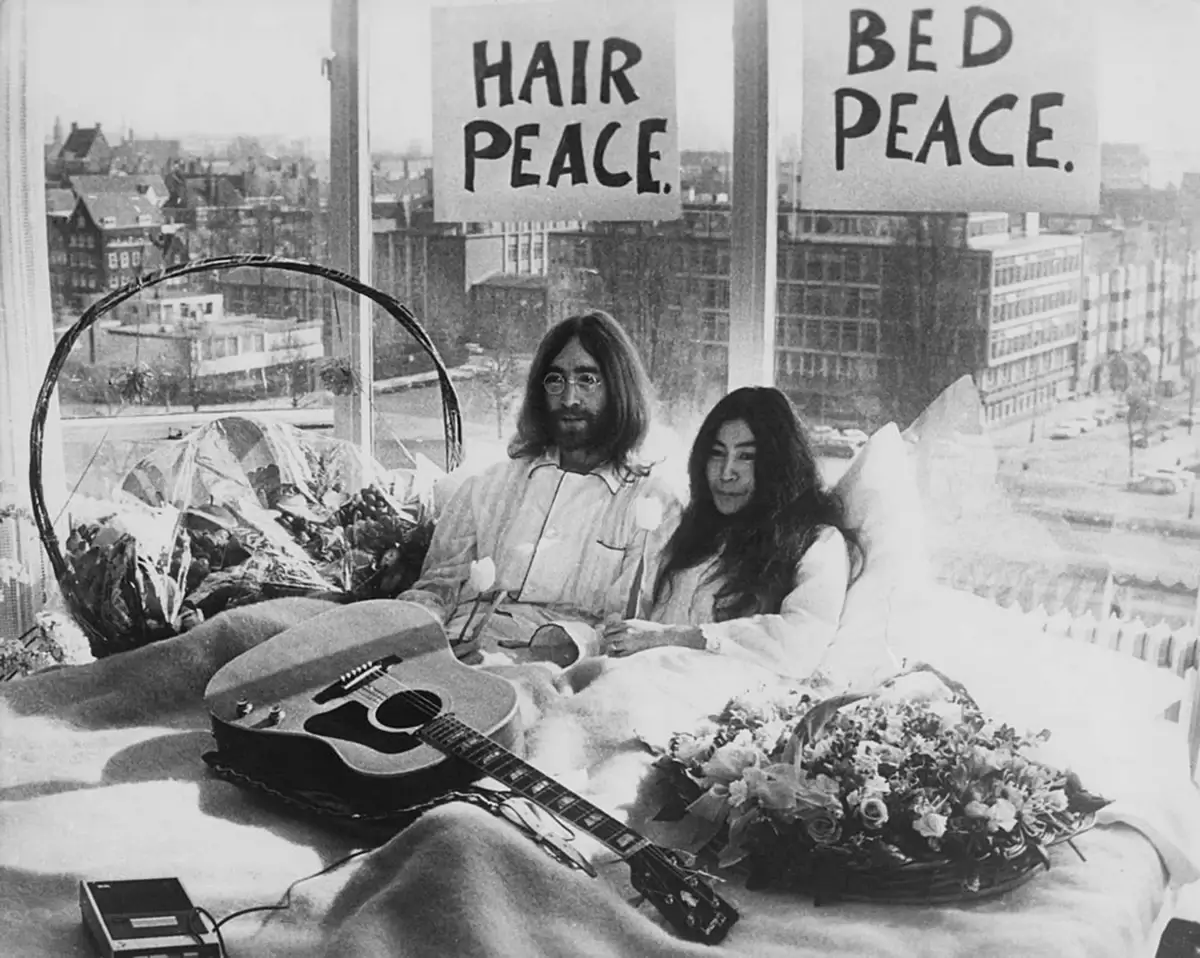
Yoko Ono, “Bed-In for Peace”, 1969. Image: time.com
Collaborative Ventures and Activism
Ono’s marriage to John Lennon in 1969 heralded a new phase in her career, marked by a blend of art and activism. The “Bed-In” performance during their honeymoon in Amsterdam was a novel protest against the Vietnam War, advocating for peace in an unconventional manner. This period highlighted her ability to fuse personal and political narratives, creating art that resonated beyond traditional galleries.
Ongoing Contributions and Legacy
Ono’s later works, like the “Wish Tree” project and the “Imagine Peace Tower” in Iceland, continue to inspire. These projects invite global participation, symbolizing Ono’s enduring message of harmony and unity. Her work transcends traditional art forms, inviting audiences to experience and live her vision.
Yoko Ono’s career is a testament to the power of art in shaping cultural and social discourse. Her unique blend of creativity, activism, and participation makes her a true icon of her time. Her legacy in the art world is marked by a diverse range of works and contributions, continually celebrated for their depth and impact.
13. Utamaro: The Luminous Artisan of Ukiyo-e

Kitagawa Utamaro, born around 1753, is enshrouded in the mystique of history. Little is known about his early life, but he emerged in Edo (modern Tokyo), initially under the tutelage of Toriyama Sekien. This mentorship was crucial in shaping Utamaro’s artistic path, influencing his move towards Ukiyo-e, a genre capturing the ephemeral “floating world” of pleasure districts. His early work was primarily illustrations for popular literature, where he honed his distinctive style.
Rise to Prominence in Ukiyo-e
In the 1790s, Utamaro’s fame soared with his unique “ōkubi-e” style, focusing on the heads and upper torsos of women. This approach offered a new, intimate perspective in Ukiyo-e, moving away from full-figure portrayals. His prints, such as “Kachō (Mosquito Net),” became renowned for their intricate detail and subtle portrayal of female beauty, mirroring the nuanced social fabric of Edo.
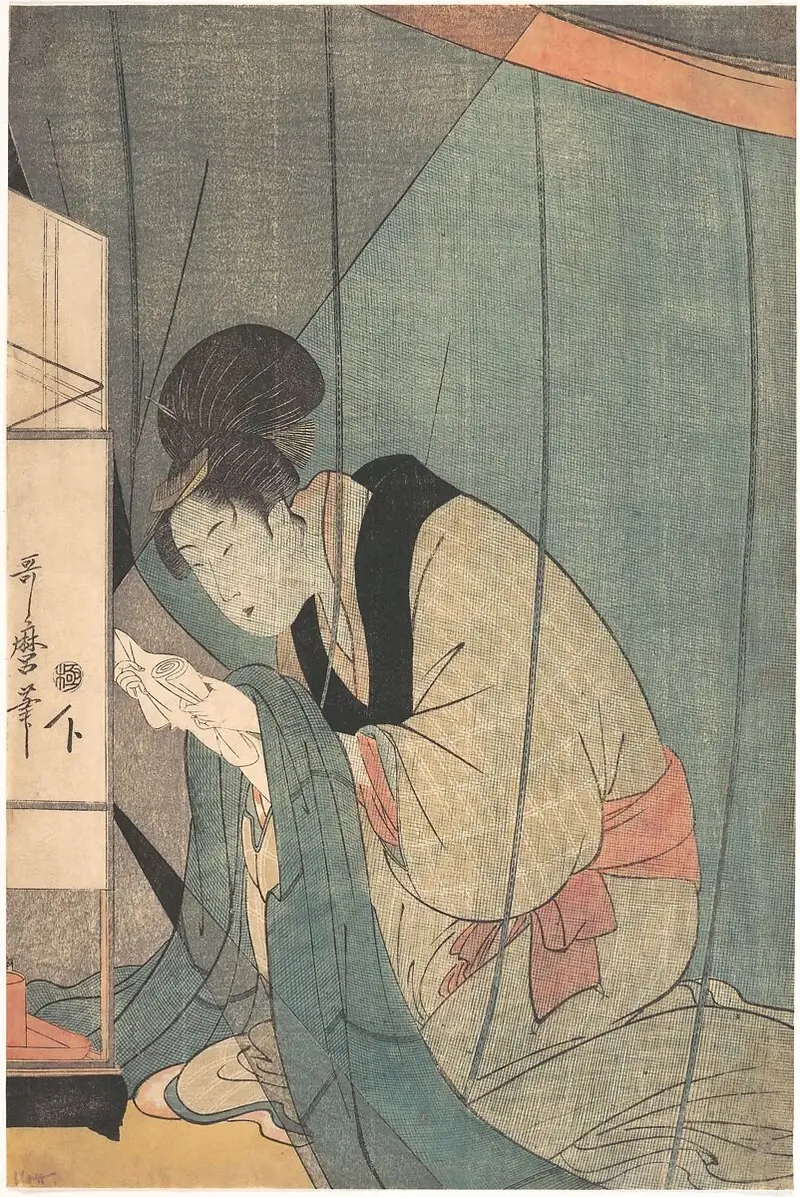
Kitagawa Utamaro, “Woman Reading a Letter under a Mosquito Net”, 1798. Image: metmuseum.org
Artistic Evolution and Legacy
Utamaro’s art transcended mere portraiture, often embodying deeper narratives and cultural commentary. His series featuring folklore characters, like “Yama-Uba and Kintarō,” showcased his ability to blend realism with myth, illuminating Japanese folklore with a delicate human touch. However, his later years were marred by legal troubles, which significantly impacted his work and personal life. Despite this, Utamaro’s legacy endures, his works representing a pinnacle of elegance and expressive depth in the Ukiyo-e movement.
Cultural Influence and Enduring Impact
Utamaro’s depictions, especially of women in various societal roles, left an indelible mark on both Japanese and Western art. His sensitive portrayals provided insights into the lives of Edo’s women, from courtesans to mothers, rendered with a grace and dignity that transcended the era’s artistic norms. His influence extended beyond his lifetime, inspiring artists across cultures and centuries.
14. Utagawa Kuniyoshi: The Innovator of Ukiyo-e
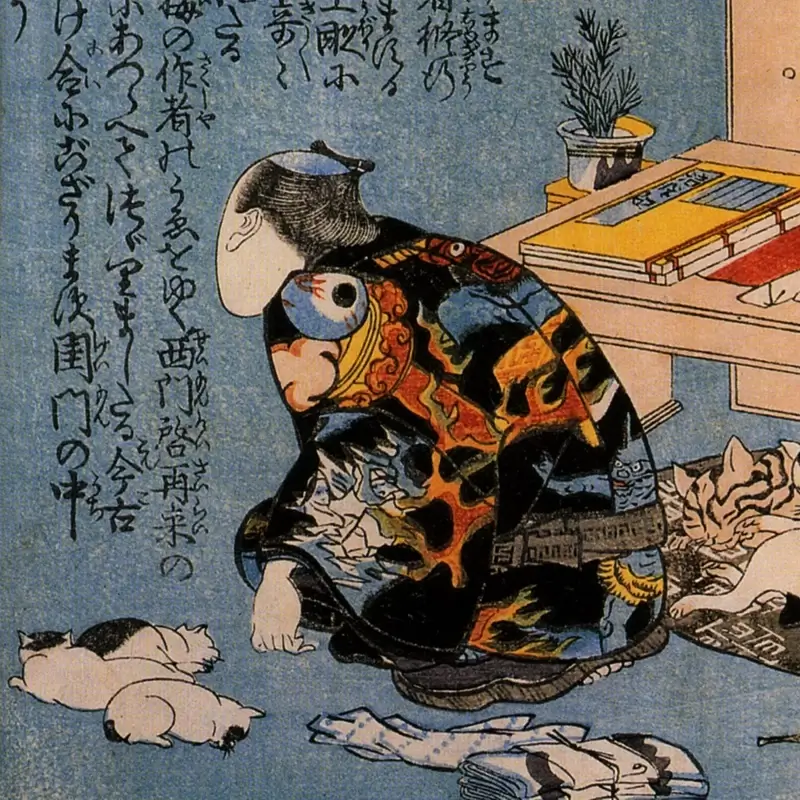
Utagawa Kuniyoshi, born on January 1, 1798, in Kanda, Edo (now Tokyo), was a masterful Japanese painter and printmaker in the ukiyo-e style. A student of Utagawa Toyokuni, Kuniyoshi initially struggled with his economic situation, even selling used tatami mats to make ends meet. This period of hardship fueled his determination and artistic development.
Breakthrough and Unique Style
The 1820s marked a turning point in Kuniyoshi’s career. His distinct style began to emerge, particularly with his series “Tsūzoku Suikoden gōketsu hyakuhachinin” (One Hundred and Eight Popular Warrior Heroes from Shui-hu ch’uan) published around 1827. This series, featuring warrior prints, catapulted him to fame. Kuniyoshi’s work stood out for its unique depiction of tattoos on his heroes, significantly influencing Edo fashion.
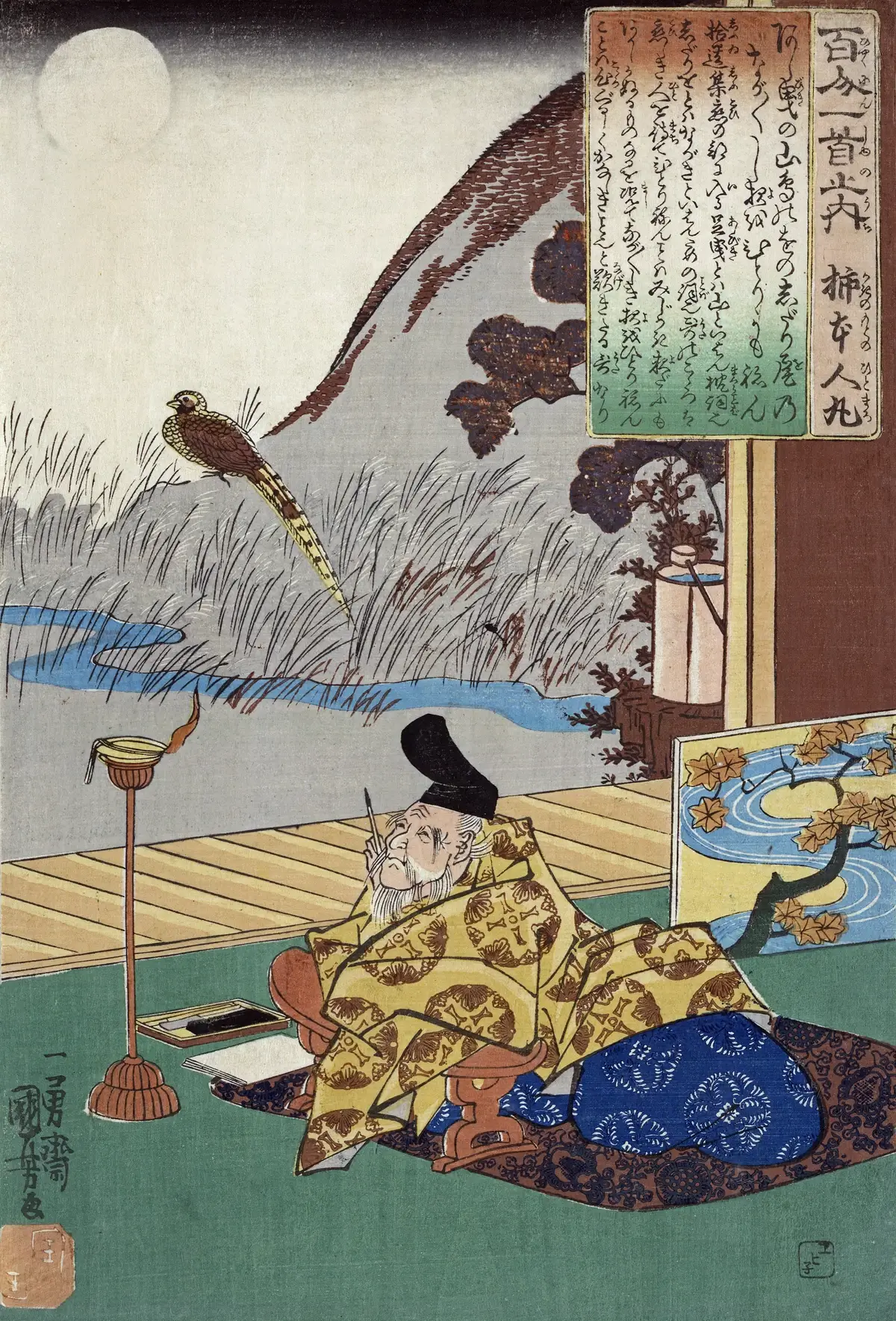
Utagawa Kuniyoshi, “Kakinomoto Hitomaro”, between 1844 and 1854. Image: Wikimedia Commons
Themes and Innovations
Kuniyoshi’s artistry extended beyond warrior prints. He ventured into landscapes, often employing Western perspective techniques. His work featured diverse themes, ranging from war tales to dreamlike, ghostly apparitions. Kuniyoshi’s prints were known for their dynamic action and intensity, tapping into the public’s growing interest in the bizarre and supernatural.
Adaptation and Legacy
The Tenpō Reforms of 1841–1843, which restricted public displays of luxury and wealth, indirectly impacted Kuniyoshi’s work. He adeptly navigated these restrictions by creating caricatures and comic prints, subtly criticizing the shogunate. This period saw Kuniyoshi innovating with landscapes, natural subjects, and even experimenting with wide composition.
Despite facing health challenges in his later years, Kuniyoshi’s creativity never waned. He passed away on April 14, 1861, in Edo, leaving behind a rich legacy as one of the last great masters of the ukiyo-e style. His influence extended to many pupils who continued his artistic lineage, including Yoshitoshi, who is regarded as the “last master” of the Japanese woodblock print.
15. Hasui Kawase: The Poet of Japanese Landscapes
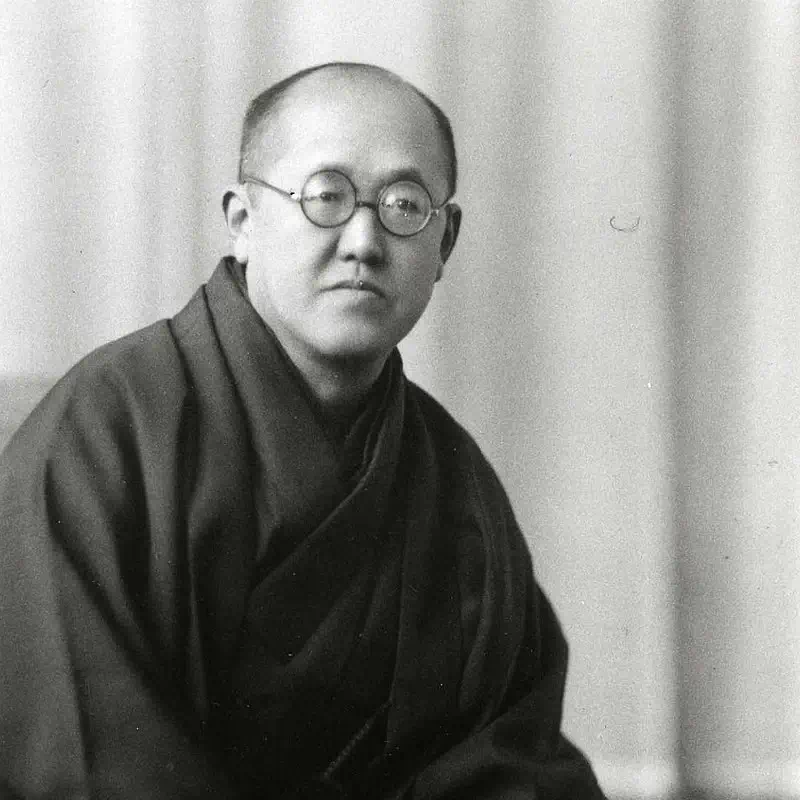
Hasui Kawase, born on May 18, 1883, initially faced a career in his family’s rope and thread wholesaling business. However, following the business’s bankruptcy when he was 26, Hasui was free to pursue his true passion in art. His artistic journey began under the guidance of Kiyokata Kaburagi, who directed him towards Western-style painting, a skill he honed with Okada Saburōsuke. Later, he returned to Kaburagi and was accepted as a student, marking the start of his path in the world of art.
Emergence in Shin Hanga Movement
Hasui Kawase became a prominent figure in the Shin Hanga movement, a 20th-century art movement that blended traditional Japanese art with Western influences. This style led to the creation of prints that presented an idealized version of Japan. Hasui’s works are known for their realistic representation of landscapes and townscapes, capturing tranquil and lesser-known locales of Japan.
Artistic Ideals and Travels
Unlike many of his predecessors, Hasui insisted on sketching landscapes he had personally visited, seeking authenticity in his work. This commitment took him on extensive travels across Japan, where he sketched scenes that he later transformed into striking woodblock prints and watercolors. His dedication to realism and his skill in capturing the naturalistic light, shade, and texture in his compositions set his work apart from other ukiyo-e artists of his time.
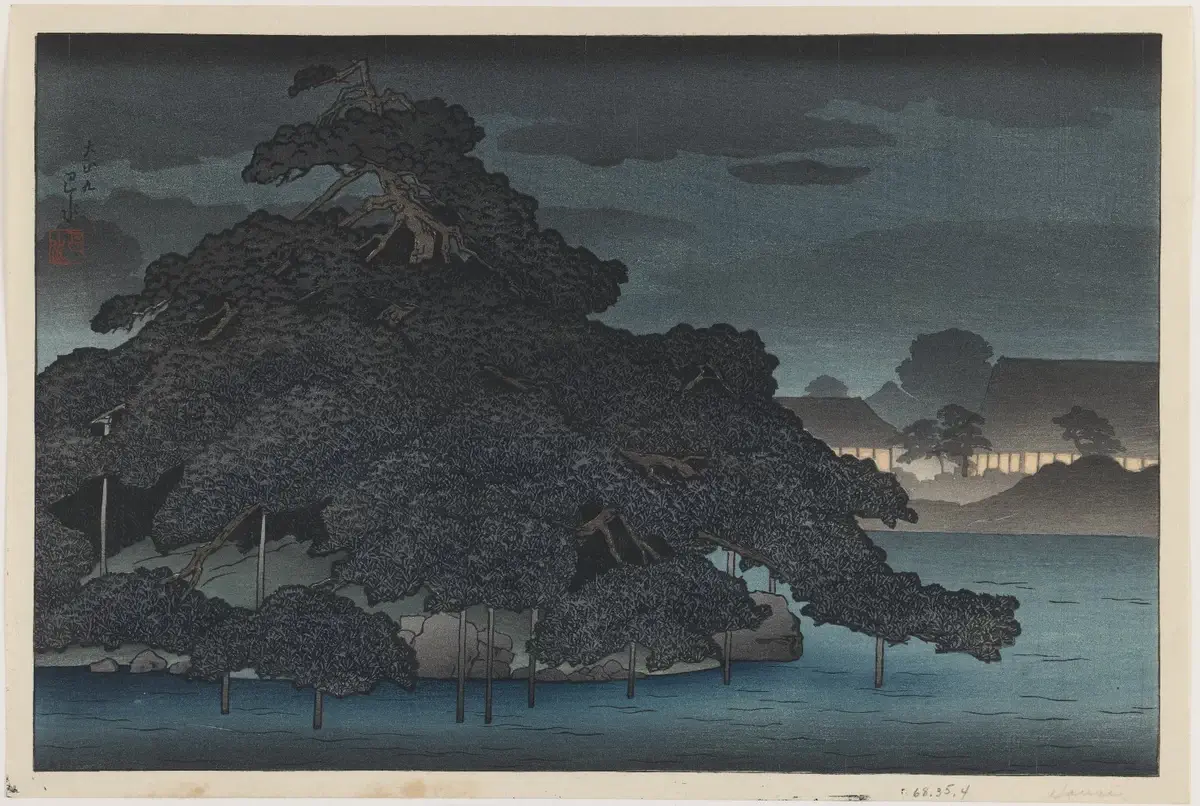
Hasui Kawase, “Evening Rain on the Pine Island, from an untitled series of views of Mitsubishi Villa in Fukagawa”, 1920. Image: brooklynmuseum.org
Legacy and Recognition
Over his 40-year career, Hasui worked closely with publisher Shōzaburō Watanabe, contributing significantly to the Shin Hanga movement. His works gained international recognition, particularly in the West, through American connoisseur Robert O. Muller. In 1956, a year before his death, Hasui was honored as a Living National Treasure in Japan.
Representative Works
Hasui Kawase’s legacy is evident in his extensive collection of woodblock prints and watercolors, many of which are linked to each other. Among his most notable works are “Twelve Scenes of Tokyo” and “Selected Views of Japan.” His snow scenes, such as the first falling snow print he designed in 1920, are particularly renowned for their originality.
FAQ
Who was the famous Japanese artist?
There have been many renowned Japanese artists throughout history, each contributing uniquely to the art world. For example, Sesshu Toyo was a Zen Buddhist monk and influential painter of the Muromachi period, known for his distinctive ink landscapes and paintings of birds and flowers. Contemporary artists like Tetsuya Ishida, known for portraying the fusion of humans with machines, and Chiho Aoshima, recognized for her digital images and exploration of yokai spirits, also hold significant places in Japanese art history.
What is Japan’s most famous painting?
While it’s challenging to pinpoint a single most famous Japanese painting, one of the iconic works is “The Great Wave off Kanagawa” by Katsushika Hokusai. This woodblock print, part of the “Thirty-Six Views of Mount Fuji” series, is recognized worldwide and epitomizes the Japanese art form of ukiyo-e.
Who is the father of Japanese art?
Tenshō Shūbun, active during the Muromachi period, is often regarded as the father of Japanese art, particularly for his contributions to the Suiboku ink wash painting style. He was influential in incorporating Chinese painting styles into traditional Japanese art.
Who was the Japanese artist with 30 names?
Hokusai, famous for “The Great Wave off Kanagawa,” is known to have used around 30 different names throughout his career. This practice was not uncommon among Japanese artists, often reflecting changes in their artistic style or life circumstances.
What is Japanese art style called?
Japanese art encompasses various styles, with one of the most renowned being ukiyo-e, a genre of woodblock prints and paintings that flourished during the Edo period. Ukiyo-e translates to “pictures of the floating world” and is celebrated for its depictions of landscapes, tales from history, and scenes from everyday life.


